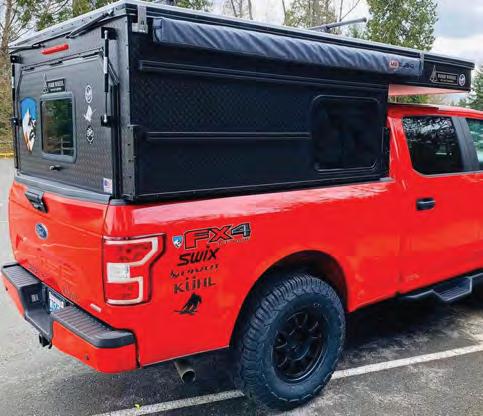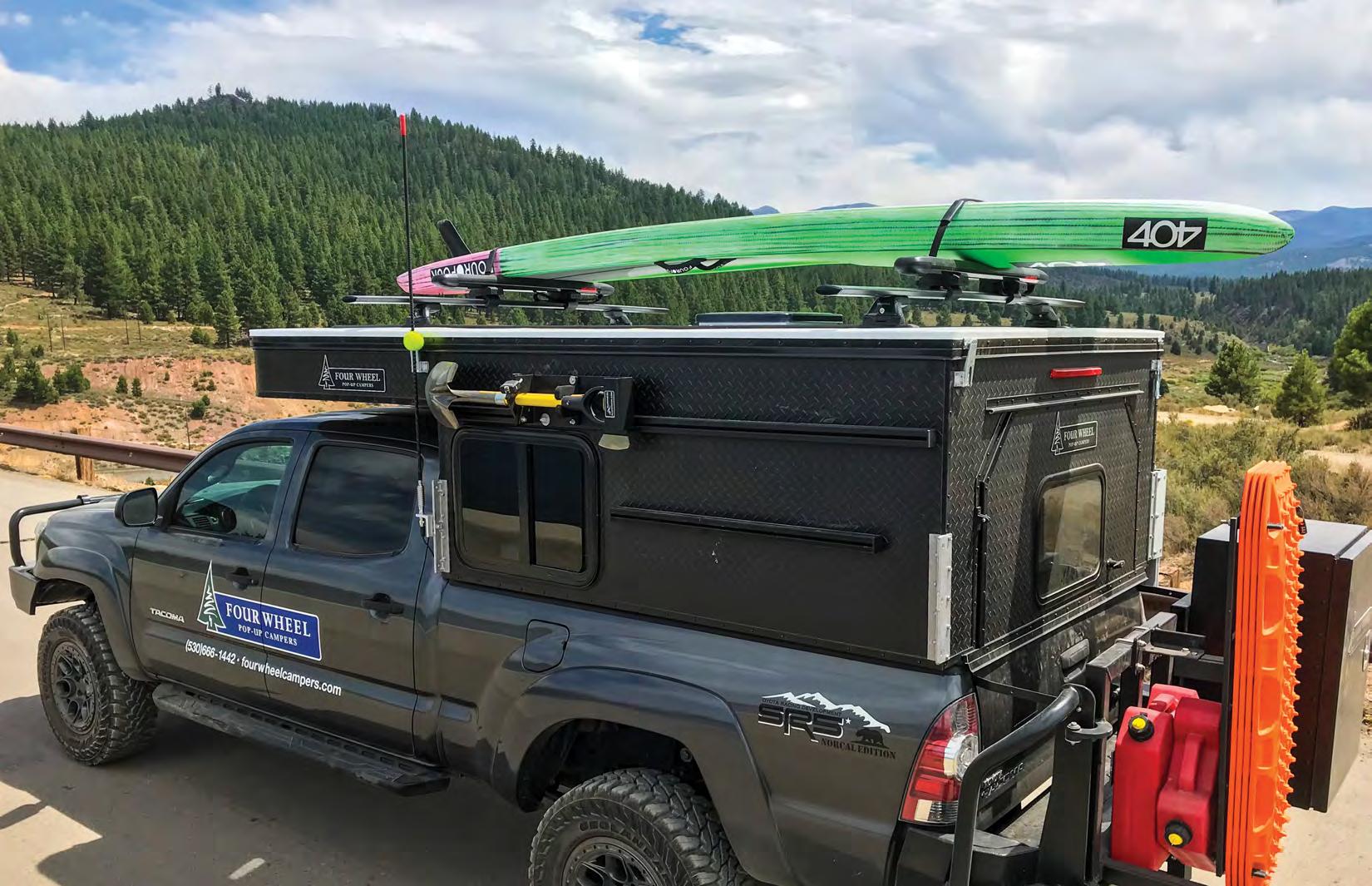














































































































































Adventure Sports Journal can’t offer likes, comments, or shares, but we can help you get stoked on outdoor recreation and stewardship in California and Nevada. Sure, we enjoy connecting with people on Facebook and Instagram, but the clickbait articles and divisive comments can be exhausting.
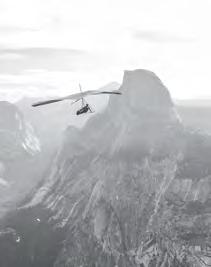



That’s when we like to set our phones down and read an article printed in the latest issue of ASJ. The experience of reading words and seeing pictures on a printed page is more relaxing, more serene, more authentic, and unlike any experience you can find online. That’s what keeps us going.

Facebook and Instagram raked in over $70 billion in advertising revenue last year, to the detriment of independent magazines like ASJ. That’s why we depend on support from companies and individuals like you. We think ASJ is an important voice for the outdoor community in California. If you agree then consider helping us continue to survive.
Please support our advertisers and become a member today. Learn more at adventuresportsjournal.com/membership.







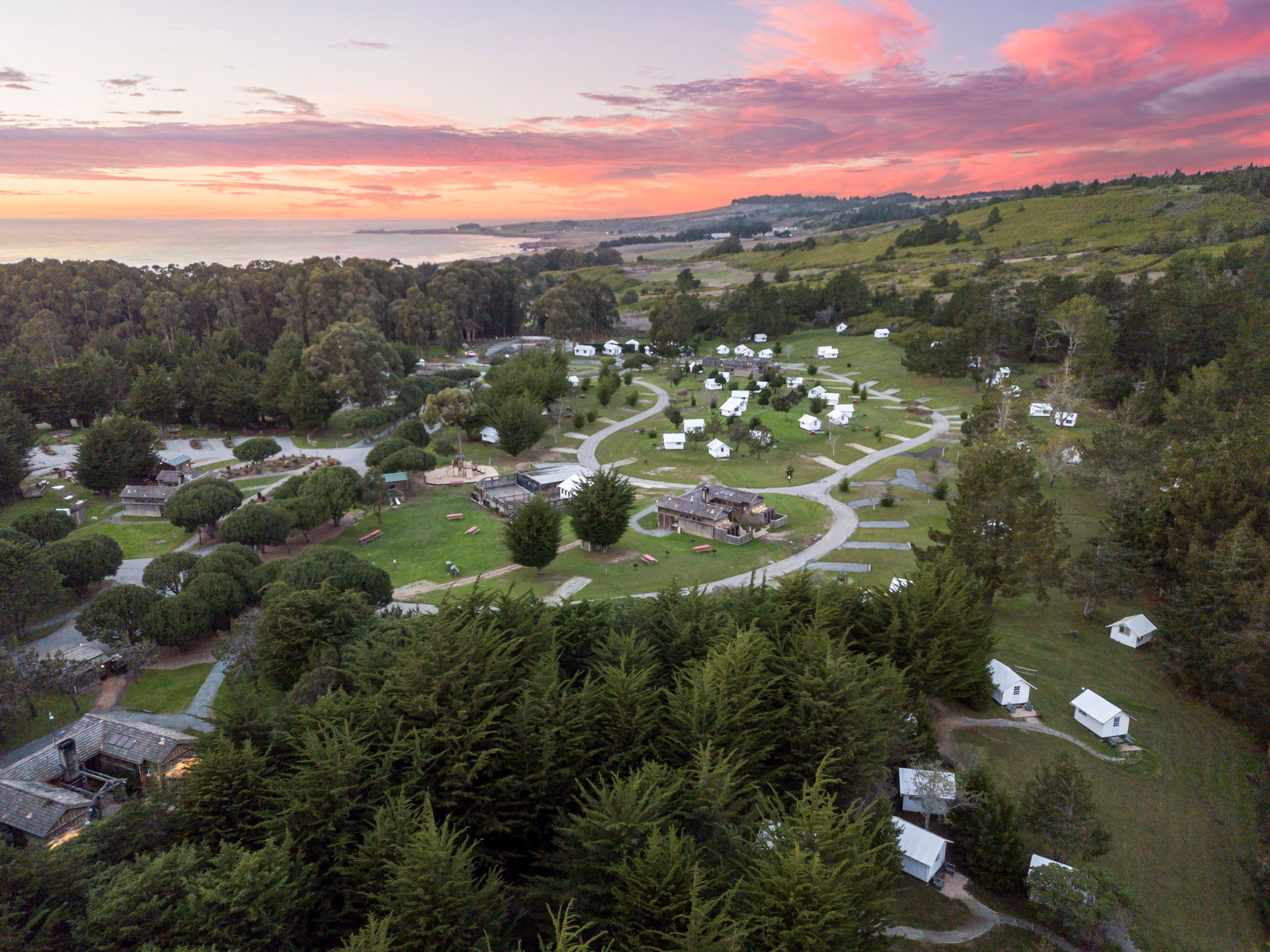

Photographer Trevor DeHaas social distancing with his well-photographed dog Kahlua on Bonsai Rock, East Shore Lake Tahoe. Read about DeHaas’ need for a kidney on page 10 and follow him @trevorandkahlua.





PUBLISHING + EDITORIAL
PUBLISHER
Cathy Claesson cathy@adventuresportsjournal.com
EDITOR-IN-CHIEF
Matt Niswonger matt@adventuresportsjournal.com
EDITOR
Michele Charboneau michele@adventuresportsjournal.com
COPY EDITOR
Jennifer Stein jen@adventuresportsjournal.com
CONTRIBUTING EDITORS
Leonie Sherman, Krista Houghton, Matt Johanson, James Murren, Allyson Gunsallus, Dani Reyes-Acosta, Justin Cummings

CONTRIBUTING PHOTOGRAPHERS
Leonie Sherman, Jay Melena, Allyson Gunsallus, Trevor DeHaas, James Murren, Dani Reyes-Acosta, Matt Johanson, Dan Milner/Trek, Shmuel Thaler
LAYOUT
Cathy Claesson
COVER DESIGN
Lauren Worth
what adventure(s) has kept you sane during COVID-19 shelter-in-place?
Sanity? These are insane times, staying sane would be crazy. But I’ve been biking, hiking, backpacking, surfing, SUPing and kayaking. The ocean, mountains and ancient trees give me a little perspective.
I had access to the Santa Cruz Mountains from my back yard, where I could hike and mountain bike for hours, the stillness of the forest would calm my fears and balance my soul.
I have been mostly trail running, with some peak bagging thrown in, both close to home.
ADVERTISING
ACCOUNT EXECUTIVE

Cathy Claesson I 831.234.0351 cathy@adventuresportsjournal.com

EVENTS & DISTRIBUTION
Matt Niswonger matt@adventuresportsjournal.com
EVENTS MARKETING
Michele Charboneau michele@adventuresportsjournal.com

Jennifer Stein jen@adventuresportsjournal.com
Opinions expressed are those of the authors and not necessarily those of Adventure Sports Journal or our advertisers. We usually agree with our articles, but sometimes we don’t. We welcome all contributions.
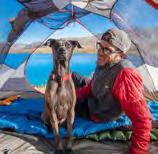
All content © Adventure Sports Journal 2020. No part of this publication may be reproduced without permission of the editors
ADVENTURE SPORTS JOURNAL
PO BOX 35, Santa Cruz, CA 95063 Phone 831.457.9453
asjstaff@adventuresportsjournal.com


I broke out the ‘90s mountain bike and started cycling. Living in the redwood trees in the Santa Cruz mountains, I can’t believe what I had been missing out on after exploring close to home.

I‘ve been getting my kicks running trails at altitude: self-care boosts my joy AND sanity.

As the Mayor during a pandemic and a national social uprising against racism, among other things, it has been quite the adventure.
I’ve been biking and hiking local trails in San Diego. Since the beaches have opened up, I have been body surfing as much as possible.

COVID-19 has made traveling come to a stand still, luckily I’ve been able to stay sane with some adventures. Using safe social distancing protocols I’ve still been able to paddleboard, surf, and hike the redwood lined trails behind my house.
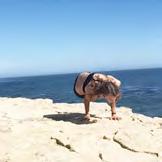

Conserving wild spaces will require EVERYONE’S help
Six months into the year 2020, we are faced with a turning point in the history of the United States and the world. We are living through the worst pandemic since 1918, the killing of black men by police in America has sparked a demand for social justice and an end to systemic racism and discrimination, and arctic temperatures recently reached 101 degrees Farenheit, the highest ever recorded in human history.
Although the impacts of COVID-19, police violence, and climate change have disproportionate impacts on people depending on their racial or socioeconomic status, geographic location, or access to resources, we do know that in order to make any meaningful change it will take a collective effort.

Of all the many threats to humanity, climate change remains the single biggest threat to the persistence of humans on this planet. Environmental conservation is critical for mitigating the impacts of climate change and maintaining biodiversity for future generations. As we continue to act and fight to protect the environment against those who would like to profit from its destruction, we must also stop to ask ourselves, who is involved in the conversation.
The American environmental conservation movement has a history that was embedded in racism. Madison Grant, friend of presidents Herbert Hoover and Teddy Roosevelt, is credited as one of the founding fathers of conservation for helping to create numerous national parks and
conservation organizations. However, the basis of his conservation ideology was that natural resources were to be conserved for people of Nordic heritage at the exclusion of other races. Historically many conservation organizations were exclusive to white men and over time women could join. When we look at conservation and outdoor recreation today, although there have been efforts to increase diversity in both, we still see that outdoor participation remains predominantly white.
Throughout my life I have heard assumptions from white people that the reason they don’t see people of color in national parks or environmental fields is because there is a lack of interest. The reality is that this lack of diversity stems from the geographic segregation of communities of color into poverty stricken “ghettos”, lack of educational and financial resources available to communities of color to gain access, and lack of inclusion into organizations and institutions that make environmental policy decisions. In fact, the environmental justice movement was largely started by people
of color, who highlighted the inequity of environmental protection in neighborhoods of people of color, which is still being fought today.
For conservation to be effective, the people who reflect the composition of our nation must be at the forefront of this conversation. This means that we must intentionally deconstruct systemic racism in outdoor recreation, create access for everyone in our open spaces, ensure that conservation and recreation are reflective of our nation as a whole, and ensure that all voices are equitably represented at the decision making table. We must look at our organizations, companies, and institutions and ask whether diversity is reflected in the composition of our workforce, in our marketing and advertising, on our boards, and whether there is a need for change. This will require questioning our biases, intentional recruitment, and creating a pathway for inclusion. Our planet needs us now more than ever, but we can only save it if we all work together.
— Justin Cummings, Ph.D.We are honored to print Justin Cummings’ guest editorial in this issue and acknowledge that ASJ has not done a good enough job at engaging a diverse community through our pages. We have work to do. As part of our commitment to antiracism we look forward to covering BIPOC athletes and organizations in upcoming issues. We want to amplify diverse voices and would love to hear from you. Suggestions are welcome.
— Cathy Claesson, Publisher & Matt Niswonger, Editor-in-ChiefAdventure Sports Journal supports the antiracist movement sweeping the globe. We believe that we will only overcome deeply ingrained systemic racism when we all take part in the fight.

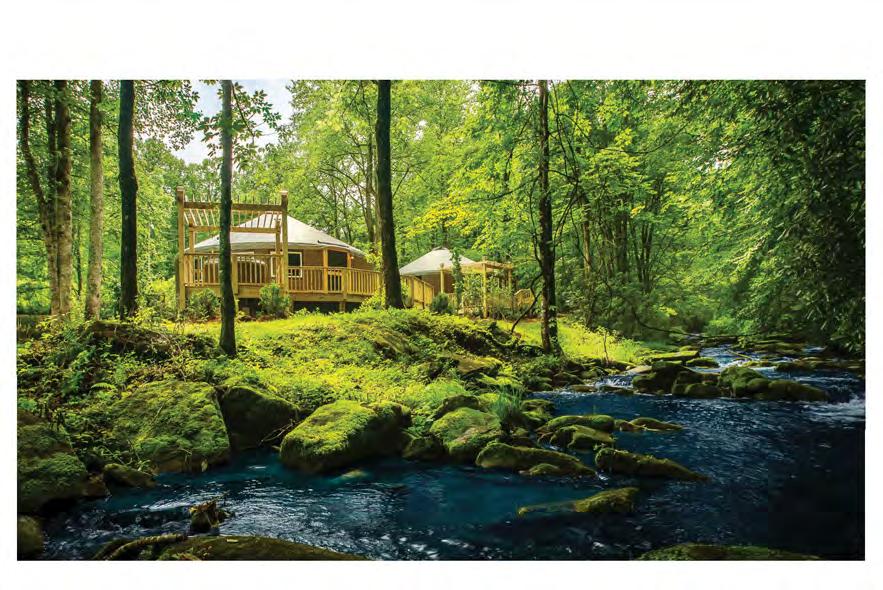

James Murren is the winner of the 2020 Gold Award in the Column category for his Earn Your Beer series in Adventure Sports Journal. The award is handed out by the Society of American Travel Writers–Western Chapter, with judging facilitated by The Missouri School of Journalism, University of Missouri, home of one of the world’s first journalism schools (1908). The judges, faculty members at the university, commented the following about the Earn Your Beer columns:
“Okay, so the premise is a little off-kilter – teaming up exhausting adventure sports with craft beer. These well-written columns are fast-paced, fun and really will get you off and exploring natural areas, with a cold brew as your reward.”

Said Murren on receiving the award, “I am both surprised and deeply honored. The idea that outdoor adventuring and independent craft brewing can come together and be recognized by experts in the field of journalism, and my peers, goes beyond anything I imagined when I started this gig. I am especially grateful to the ASJ editors for taking a chance on my writing.”
Read more at asjmag.com/eyb-column-wins-gold.

On June 19 The North Face announced it would stop buying Facebook ads in the US, in solidarity with civil-rights groups like the NAACP, the Anti-Defamation League, and Sleeping Giants, effective immediately. In a follow-up statement, The North Face also said they would be halting paid advertisements on Instagram — which is owned by Facebook.
The North Face has become the first major brand to boycott Facebook on the heels of mounting pressure from civil-rights organizations over the platform’s contentmoderation policies and handling of hate speech in the aftermath of George Floyd’s death.
“We know that for too long harmful, racist rhetoric and misinformation has made the world unequal and unsafe, and we stand with the NAACP and the other organizations who are working to #StopHateforProfit,”
Steve Lesnard, The North Face’s global VP of Marketing, said in a statement.
As we go to press, Patagonia has announced it will also stop buying ads on Facebook effective immediately.
Learn more at asjmag.com/stop-hate.
On June 17 the US Senate passed the Great American Outdoors Act with bipartisan support. The GAOA fully funds the Land and Water Conservation Fund (LWCF).

In 1965, Congress created the LWCF to help conserve natural areas, culturally and historically significant landmarks, and outdoor recreation opportunities. The vision was simple: reinvest a portion of revenue from offshore oil and gas to conserve land, water and recreation resources. Since 1965, LWCF has invested more than $16 billion to land, water, and outdoor recreation in all 50 states.
“Public lands drive our juggernaut outdoor economy, which generates $887 billion in consumer spending every year. This bill will inject money into our economy, create jobs, and make the repairs that our public lands and land infrastructure need,” said Senator Maria Cantwell (D, WA) in a recent press release.
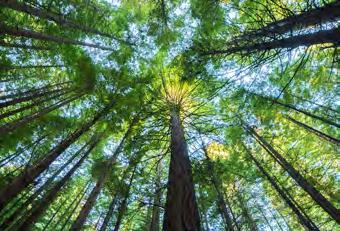
Moving forward these LWCF funds will fund trail projects and other economic and recreational opportunites.
Read more at asjmag.com/gaoa.

This September 22-27, the Yosemite Climbing Association will host the 17th annual Yosemite Facelift with copresenting sponsor, The North Face, and co-host and official vehicle, Subaru.
Facelift 2020: Act Local calls on you to connect with your love and appreciation of Yosemite National Park and other national parks and apply the same care to the outdoor spaces around you, locally! Programming will be presented virtually online and participants will have opportunities to win prizes by engaging through social media.
Read our article on page 10 for more information and visit yosemitefacelift.com for updates and even more info.

The “Bike for a Healthy California” license plate is steadily making progress toward its goal of 7,500 presales. This plate is appropriate for cars, trucks, motorcycles and trailers, and supports a California grant program for county health offices, schools, nonprofits and community based organizations. Grants will focus on safe places to ride bikes, Earn-A-Bike programs, school programs, the promotion of bikes as transportation, and safety education.
Learn more about these initiatives and get pre-order information at asjmag. com/bike-plate-update
Photographer Trevor DeHaas has lived with an autoimmune disease called IgA Nephropathy for the past 20 years. Unfortunately there is no known cause or cure for this disease. Between both of his kidneys, he only has 10% functionality left so he has two options: get a kidney transplant or live on dialysis until he dies. Unfortunately the waitlist for a kidney where he lives (Santa Cruz) is 10 years, and he most likely will die before then. Follow DeHaas on Instagram @trevorandkahlua. Learn more about kidney donations and the opportunity to save a life at asjmag. com/trevor-needs-a-kidney.

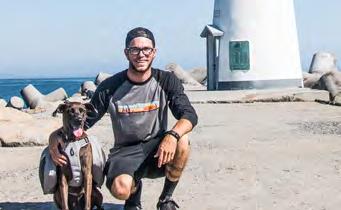
Visit California launched a Responsible Travel Code that asks visitors to travel with RESPECT when exploring the Golden State, including putting safety first while also remembering to preserve California for future generations. The code lives on the newly launched VisitCalifornia.com as part of a Responsible Travel Hub. The Hub is a resource for travelers, demonstrating ways they can do their part to travel safely and responsibly, while also sharing what businesses and communities are doing to ensure the safety of their guests. Learn more at asjmag.com/visitcalifornia-travel-code.
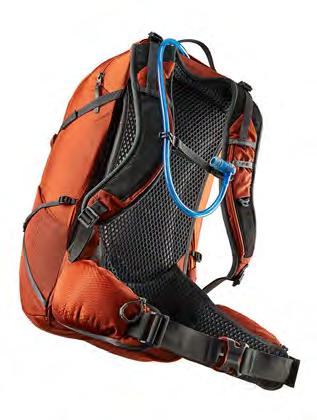

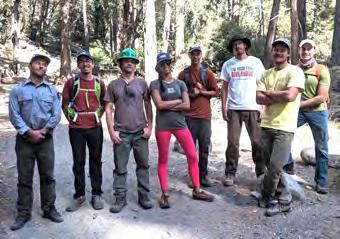
Instead of focusing on their woes of canceled orders and profit numbers going down, Western Mountaineering turned their attention to helping frontline health care workers who were facing a PPE shortage due to the onset of COVID-19. They began donating two varieties of high quality adjustable masks for health and support organizations in the Bay Area. After the initial donation, they started selling the masks to local municipal agencies and are now available for indivdual purchase online for $10 each. Customizable options are available as well.

Learn more at asjmag.com/wm-masks
California Enduro Series (CES) recently launched this year’s fundraiser, made possible by title sponsor Specialized. Two Specialized bikes will be raffled off, with a portion of the proceeds going to trail organizations in communities that host series races: Rogue Valley Mountain Bike Association (RVMBA) and Siskiyou Outdoor Recreation Alliance (SORA). The winning tickets for a 2020 Turbo Levo SL Comp Carbon and 2020 Enduro Expert will be pulled at the end of the CES season. Learn more at asjmag.com/ces-specialized-levo

There are lands on this earth so spiritually alive that they light a fire in our souls. We know these places are sacred because we are spellbound by their majesty. In the aftermath of our experiences there, we recall vivid moments of deep connection with nature. These moments are slightly different for everyone, but the feeling is the same: the first time we see the high mountains; the magic of alpenglow on the Cathedral Spires in Yosemite Valley; the ocean sunrise while surfing next to dolphins. In these moments we would do anything to preserve that sense of deep natural connection. Many of us will spend the rest of our recreational lives seeking the same feeling.
In recent months, more people than ever have turned to the outdoors for a reprieve from the stress and emotional exhaustion of life. A return to “business as usual” eludes us. In addition to the regular hikers, cyclists, climbers, and surfers relying on their favorite local wild places for an escape from tensions caused by the COVID-19 public health crisis, a new generation of outdoor users is being born. This trend started soon after shelter-in-place and stay-at-home

measures took effect. Bob Doyle, General Manager of the East Bay Regional Parks District, reported in a March 25 San Francisco Chronicle article, “In my 45 years of park work, I’ve never seen these types of crowds, not ever. People are desperate to get outside ... visitation is insane.”
The increase in visitation has been so great in some areas, parks have even had to close. For instance, on May 12, Teton Gravity Research reported that “dispersed
camping in Oregon State Forests [has been] banned due to excessive trash and human waste.”

With travel curtailed, local public parks and beaches have come to occupy the general level of sanctity previously reserved for only the grandest national parks and wonders of the world. This shift creates an opportunity for us to reorganize our appreciation of public outdoor spaces and to take better care of public parks and beaches.
Putting aside the public health risks of crowds during a
In the face of current challenges, we have an opportunity for positive change
viral pandemic, increased visitation poses additional concerns for land managers and park infrastructure. Trash cans in parks are overflowing, creating hazards for animals and impacting flora. Local climber organizations (LCOs) are concerned about challenges and potential access issues as well, so much so that Katie Goodwin of The Access Fund organized a virtual conference on April 30 for California climbers to discuss “ideas, challenges, successes, and concerns related to promoting stewardship with your local community during the COVID-19 health crisis.” One key theme in the meeting was how to communicate good stewardship practices to land users who may be experiencing the joy and healing of outdoor recreation for the first time.

Why do people become lifelong stewards of the land? Yosemite Facelift, the largest cleanup of a national park in the country, gathers more than two thousand volunteers, a large portion of which are climbers, every year. Climbers have a unique relationship with Yosemite because they’ve toiled on the granite walls around the park, investing their literal blood and sweat in the landscape. Considering the deep emotional connection climbers have with Yosemite, it seems natural that they would be compelled to take care of the park; people take care of what they love.
Now more than ever, we love our local parks as well. We’re beginning to understand that all of our outdoor places fulfill a sacred need in our human lives. By cultivating the deep spiritual connection with our local public lands, we may be able to partner with the land in order to take care of it better, rather than treating it like an inexhaustible resource. Events like Yosemite Facelift have recognized the potential value in this shift. On May 12, event coordinators announced it will be hosting a virtual event and calling on people to “act local.” Historically, it’s been easy for us to feel compelled to take care of places like Yosemite; it’s now more natural than ever to extend this high level of care to local public spaces.
The current public health crisis has created the need to get outdoors more than ever. While the increase in the number of outdoor enthusiasts poses the potential risk of increased impact, it also opens the door for us to cultivate increased awareness of impact issues locally by calling on our memory of spiritual connection with sometimes distant places. In the face of new challenges caused by COVID-19, there is an opportunity for us to do better than before and take care of the local places we have a newfound love for.






In trying to navigate life during a pandemic, let’s not become the very thing we abhor: a human virus that kills nature while spreading a real virus that kills humans. We believe that recreation in public lands is more fulfilling when combined with service and responsible behavior. When done right, outdoor adventure is both selfish and altruistic at the same time. By adding a service component to our public lands visitation we bring out the best in ourselves and others. We also have more fun and make friends in the process. This mindset will help us adjust to the many changes that are coming as parks and beaches reopen. Here are some ideas of how you can get involved by sport:

CLIMBING Participate in Yosemite Facelift’s virtual “act local” clean up and follow Access Fund for up to date advocacy information. Connect with your local climber organziation in California — asjmag.com/local-climber-organizations
CYCLING Road cycling, bicycle commuting and mountain biking have all seen a boom since the onset of COVID-19. Get involved with your local cycling group or MTB trail stewardship organization to see how you can support their efforts. Also consider purchasing a California Bike Plate to promote cycling in California — asjmag.com/local-cycling-groups.
HIKING/BACKPACKING/RUNNING Bring along a bag and gloves to pick up trash on your hikes and runs, even if it’s just a small bag — every little bit helps! Check in with hiking organizations such as the Pacific Crest Trail Association (PCTA) to support their efforts to clean up and maintain trails — asjmag.com/local-hiking-running-organizations.

SURFING/SWIMMING Participate in a solo beach clean up with the guidelines put forth by the Surfrider Foundation and get involved with local coastal non-profits — asjmag.com/ ocean-organizations.
PADDLING Pack a bag and gloves on your next paddling adventure so you can be prepared to snag any trash along the way — asjmag.com/surfing-organizations.
Putting aside the public health risks of crowds during a viral pandemic, increased visitation poses additional concerns for land managers and park infrastructure.Trail Series

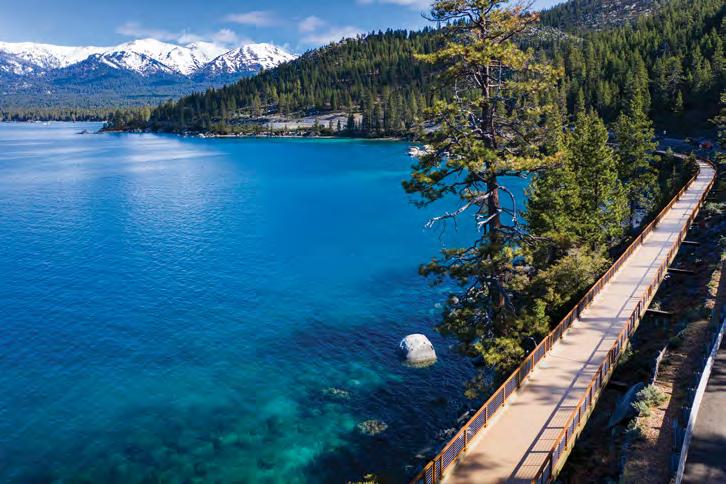
 By Leonie Sherman
By Leonie Sherman
While COVID-19 cases continue to mount and antiracist protests command global attention, the giant forests, granite domes and alpine lakes of California provide perspective and solace. After months of sheltering in place, many are eager to soothe their souls with some wilderness therapy.

Unfortunately, greedy politicians are already using this historical moment to dismantle environmental protections. The places we love need our protection now more than ever. If a visit to Lake Tahoe is on your post-COVID agenda, rest assured that the League to Save Lake Tahoe has continued to monitor and protect the lake during these uncertain times.
They’ve been protecting the lake for over 60 years. Without their hard work there would be a four-lane highway ringing the lake, and close to a million more people living on its
the words “Keep Tahoe Blue.” The League has distributed over three million of them and they adorn water bottles, bumpers and bear boxes around the world. It’s been translated into three languages. “Keep Tahoe Blue” has become the rallying cry for lake lovers everywhere. But the League to Save Lake Tahoe does so much more than make stickers.
Strolling on the spectacular new East Shore Trail from Incline Village to Sand Harbor will do that for you, it sure does it for us. We were proud to work with 12 partners to bring this path to life. It is not too late to leave your legacy on the path with a trout or a bear, or on the new donor wall.
To find out more, emai l : INFO@TAHOEFUND.ORG

OPPOSITE PAGE, TOP TO BOTTOM: THE LEAGUE AND PARTNERS HAVE INSTALLED MORE THAN 100 CIGARETTE DISPOSAL CANISTERS AT HIGH-TRAFFIC LOCATIONS AROUND THE LAKE TO KEEP CIGARETTE BUTTS ONE OF THE MOST-LITTERED ITEMS FOUND ON TAHOE BEACHES OUT OF THE ENVIRONMENT; EVERY JULY 5, THE LEAGUE ORGANIZES HUNDREDS OF VOLUNTEERS TO CLEAN UP THOUSANDS OF POUNDS OF LITTER FROM BEACHES LEFT TRASHED AFTER INDEPENDENCE DAY CELEBRATIONS. THIS PAGE, CLOCKWISE FROM TOP: A REMINDER WHY THE LEAGUE HAS WORKED SINCE 1957 TO KEEP TAHOE BLUE; THE LEAGUE TO SAVE LAKE TAHOE FORMED IN 1957 TO DEFEAT A PROPOSAL TO BUILD A BRIDGE OVER EMERALD BAY, WHICH WAS PART OF A PLAN TO BUILD THE TAHOE BASIN INTO AN URBAN CENTER THAT WOULD HAVE MATCHED SAN FRANCISCO IN SIZE. THIS IS A RENDERING OF THE PROPOSED BRIDGE, COURTESY OF CALTRANS; LEAGUE STAFF MEMBER EMILY GRIFFIN COLLECTS A WATER QUALITY SAMPLE DURING SNAPSHOT DAY, AN ANNUAL SURVEY CONDUCTED OVER ONE-DAY TO ASSESS THE HEALTH OF THE TAHOE BASIN WATERSHED.
They got off to a dramatic start in 1957, blocking the construction of a bridge across Emerald Bay and a four lane highway along the shore as part of a San Franciscoscale development around the lake that would have transformed it into a “city with a hole in the middle.” In the ’70s they put a stop to the practice of dumping sewage into the lake. Throughout the ’80s and ’90s they established stricter requirements for development near the shore, effectively limiting development to lake-friendly projects. The League advocates for lake protection on all levels, which has unlocked more than $2 billion in funding to defend and restore the lake.

These days their focus has shifted slightly, but their commitment to protecting the
“Keep Tahoe Blue” has become the rallying cry for lake lovers everywhere. But the League to Save Lake Tahoe does so much more than make stickers.



72 miles of pure liquid fun
Lake Tahoe Water Trail
Plan your paddle adventure at LakeTahoeWaterTrail.org

• Launch & Landing Sites
• Paddle Routes & Trailheads

• Paddle Shops & Outfitters

• Campgrounds & Lodging
• Water Safety & Stewardship
Order your waterproof Map & Access Guide at LakeTahoeWaterTrail.org
lake has not. “The natives called it the lake of the sky. It’s a jewel and needs to be cared for. A lot of people take it for granted,” explains Will Evers, Vice-President of the Board. For Evers, protecting Lake Tahoe is all in the family; his father was a founding member of the League, active in the fight against that four-lane highway, and his childhood summers were spent at the lake. “When I was a kid, I spent my summers swimming all day long. When I used to grab the ladder at the end of the pier there was never any algae on it, just wood. Now it’s covered in algae. The rocks were never slippery, now they are.”
The culprit, of course, is us. ”Lake Tahoe gets 24 million visitors a year, more than the top three national parks combined,” says Evers. All those visitors arrive in cars. “Traffic is one of our biggest issues right now,” he continues. “The sand they put down in the winter for the snow gets pulverized by the cars and causes lake turbidity.” According to Evers, lake clarity is measured by attaching a white dinner plate to a rope and dropping it over the edge. In 1960 they could still see that plate
THIS


A BUBBLE CURTAIN IN THE TAHOE KEYS — GROUND ZERO FOR THE INVASIVE WEED INFESTATION IN LAKE TAHOE — TO PREVENT THE SPREAD OF AQUATIC INVASIVE WEEDS FURTHER INTO LAKE TAHOE ITSELF. THIS EARNED THE LEAGUE A 2019 BEST IN BASIN AWARD; THE LEAGUE WAS INSTRUMENTAL IN COORDINATING THE 1997 TAHOE PRESIDENTIAL FORUM, ATTENDED BY PRESIDENT CLINTON AND VICE PRESIDENT GORE. THE NATIONAL FOCUS OPENED THE DOOR TO BILLIONS OF DOLLARS IN FUNDING FOR TAHOE ENVIRONMENTAL PROGRAMS.
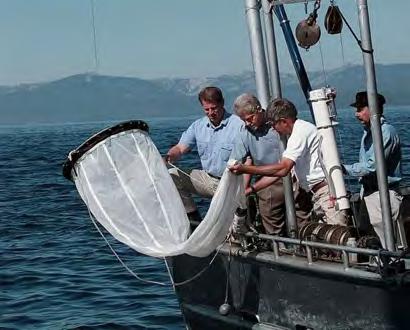
feet down. These days the plate is visible to less than 63 feet. The League realized that a lot of local workers and tourists were driving a mile or so to get to their jobs and introduced a bike and scooter share program that was wildly popular until the COVID crisis. The League has not figured out post-COVID incentives to reduce traffic. Hopefully they look like Italy, where they are subsidizing the purchase of new bikes, or France, where the government is paying for bike maintenance.
Another huge issue is development and aquatic invasive species. “The Tahoe Keys, with 1,700 homes densely clustered around a man-made marina, are ground zero for growth,” Evers explains. “The water there is so polluted, even dogs can’t swim in it because it will make them sick.”
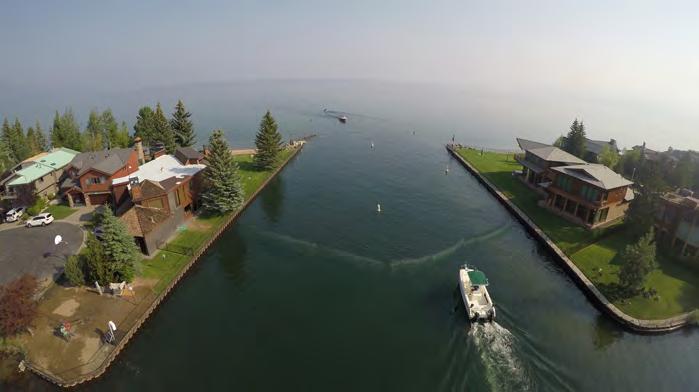

Part of the problem is runoff, but exotic weeds contribute to the issues as well.
“Every year when they would dredge the marina, bits of these invasive plants would escape and spread throughout the lake,” explains Evers. Those weeds choke out other plants and create a perfect breeding ground for other invasives. The League has come up with an innovative method to prevent the spread of those exotic species. They’ve placed PVC tubes perforated with holes underwater at the entrance to the marinas. When they pump air through the PVC tubes, a curtain of bubbles rises. This technology is used in salmon farming to contain the fish and has worked so well to prevent the spread of invasives that the installation won an award from the Tahoe Regional Planning Agency last year.
Perhaps the League’s most important recent innovation was bringing Darcie
Collins on board as CEO in 2011. Like Evers, Collins has a lifelong connection with Lake Tahoe. She grew up in the Tahoe basin and was the first intern at the League during her junior year of high school. That experience set her down the career path of bringing scientific knowledge to policy creation. She pursued a graduate degree in Environmental Science and Management and ran a community engagement program at Save the Bay in the San Francisco area for years. But she jumped at the chance to relocate to Tahoe as the League’s CEO. “When I started working here we were primarily an advocacy group,” explains Collins. “We had a strong policy team, working at the state and local level to address development projects or bring public funding, but a huge disconnect between what we were doing and the general public. Without support from the broader community about lake impacts it’s hard to have a strong program that protects the lake.”
Drawing from her experience with community engagement in the Bay Area, Collins began promoting community beach clean ups, training locals to identify invasive species and monitor runoff. “We started a citizen science program in 2013 called Pipe Keepers, where we train volunteers to collect stormwater samples,” explains Collins. First they needed to identify every single pipe draining into the lake, and then they assigned volunteers to collect samples of runoff. This helped identify which pipes were bringing more pollution. “Maybe even more importantly, through that program we educated all those volunteers about the impacts of stormwater and runoff,” she continues. “Those folks have
“Lake Tahoe gets 24 million visitors a year, more than the top three national parks combined”
— Will Evers, VP of the Board
gone to local decision makers to pressure them to improve runoff infrastructure and implement better environmental policies to decrease stormwater runoff.”

In addition, the League was able to get the city of South Lake Tahoe to pass a single use plastic bag ban, as well as a ban on styrofoam products a few years ago, thanks largely to community engagement.
“We used our beach clean ups to collect data on the types of trash left on beaches,” explains Collins. That data showed that single use plastic bags are a significant portion of beach litter. “We were able to
demonstrate the impact to the lake of plastic. Most of the communication with the city council was from our volunteers. It’s so much more impressive when politicians hear from people who are volunteering their time to take care of the lake instead of our staff members.”
The League takes care of their volunteers, and the volunteers take care of the lake, creating a positive feedback loop that Keeps Tahoe Blue. Vesper Rodriguez, a core volunteer who also grew up in Tahoe, got involved with the League’s activities through a class at the community college.
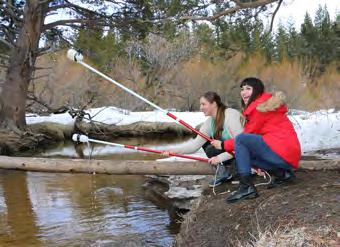




“We got to participate in this project called snapshot day, taking water samples from different parts of the basin,” she explains. “It was so much fun I really wanted to stay involved and volunteer, it was like an opportunity to do community work but have fun at the same time.” Now when friends or family come to visit, she brings them to League clean up events where they can share in the fun too. As community engagement grows, so too does agency over the lake and the desire to preserve it for future generations.
While the Coronavirus has dramatically reduced visitors to Lake Tahoe during the spring of 2020, summer numbers, and the future in general, are unpredictable. What is predictable is that the League will continue to work with the community to protect the second deepest lake in the country. “We take a pragmatic approach, where enjoyment of the lake today is balanced with preservation of the lake for the future,” Collins says. “We can and should treat this situation as an opportunity to form new environmentally friendly habits by examining what we consume and how we get around.”

Did you know that watercraft are the largest source of spreading aquatic invasive species (AIS) into new waterways? Make sure you know how to check your boat, board and gear for AIS before entering the lake. The best way to prevent AIS is to always clean, drain and dry your gear after exiting the water. TahoeKeepers.org is a great resource for learning how to do your part to protect Lake Tahoe from AIS.
After you’ve checked your gear, makes sure you have a plan before doing any paddling or adventuring on Tahoe’s big alpine lake. Do not underestimate the serious conditions that can come, sometimes without warning. Always make sure to check the wind and weather before getting on the water, and let people know what your plan is.
The Sierra Business Council released the Lake Tahoe Water Trail Map & Access Guide last year to help paddlers safely find their way along the 72-mile water route. The access guide is intended to be used with the Lake Tahoe Water Trail website and is a great resource for planning your next adventure. Maps are still available for purchase at LakeTahoeWaterTrail.com

The trauma of that event never left her. Developing a toolkit for coping allowed her to transform the pain. Instead of letting trauma define her, she let it inspire her.
protect the planet and help other women. “I realized I’d never saved a baby harp seal, or met Jacques Cousteau,” she says with a sigh. “I felt like I’d just been wasting my life.” The trauma of that event never left her. Developing a toolkit for coping allowed her to transform the pain. Instead of letting trauma define her, she let it inspire her.
While under witness protection in the UK and France, Eriksen earned straight As and, subsequently, an invitation to be a field assistant at a tropical ecology program at the University of Florida. She finished her degree where she started it, this time as a star pupil. Just two years after the incident in the shopping mall, she was chosen to help set up a year long program in Belize protecting peccaries, tapirs, monkeys and jaguars. While recovering from malaria in the field camp she met a professor who invited her to apply for a Master’s Degree at Duke University in what became their Nicholas School of the Environment. Fresh out of Duke she was hired as a Marine Scientist at Virgin Islands National Park.
Only days before Governor Newsom issued a shelter-in-place order, less than four months after returning home from sailing across the Atlantic Ocean, Rikki Eriksen fled the Golden State for the Caribbean. “I’d rather get stuck on my boat in St. John,” she explained two days before she made a hasty departure. “I can keep working and be closer to my family there.” She’s still working as Program Director for the California Marine Sanctuary Foundation, devoting every day to protecting California’s network of 124 marine protected areas, only now she’s doing it from her 44-foot boat in St. John, instead of her usual office above Abbott Square in downtown Santa Cruz. “I found my happy place all by accident,” she enthused in a recent email. Nobody who knows her is surprised. Transforming adversity and challenge into growth and opportunity is sort of her signature move.
Eriksen grew up on the water. Summers were spent on a sailboat in Denmark with her grandparents, winter break was devoted to sailing in the Caribbean with her parents, while the school year offered swimming and snorkeling on Florida’s east coast intracoastal waterway. “My backyard was a playground, we had sharks and rays and manatees and sea turtles and crystal blue water,” she explains. “And I watched that system choke to death, starting when I was 10 or 11. I used to run around as a teen pulling real estate stakes out of the ground. I realized that those of us fortunate enough to grow up there had to do something to protect the place.” But by the time she reached college, she was a surfer girl, coasting by with mediocre grades. “I had so many advantages, but I wasn’t giving back.”
Then at the age of 19, Eriksen was kidnapped from a shopping mall by a serial killer. After being held captive and tortured for three days, she decided to fight back. The
resulting melee was scrappy and brutal, but she managed to escape into the bathroom of the motel where he’d taken her. She locked the door, crawled into the bathtub and waited for him to shoot the lock off the door and kill her. He left her for dead. Eventually she crept out of the bathroom, wrapped in a bloody bed sheet, and sought help from the motel clerk. “I thought about so many women who are trapped in slavery all over the world and drew strength from them to get me through,” she says. “I also realized the privileged bubble I had been living in.” The following months were chaotic. Her father enrolled her in a six week long Outward Bound program including a three day solo. People at school pointed and whispered about her; she went into witness protection in Europe. She struggled with survivor’s guilt. “I would obsess about why I survived when other women who seemed more worthy had perished,” she admits. She realized that getting through this ordeal gave her the chance to work to
While living the idyllic life of a tropical island marine protector, Eriksen got married and had a son. By the time her son was four months old, her marriage had disintegrated. Instead of licking her wounds, she moved to Hawaii, newborn in tow, as a single mom. But when the US Geological Survey invited her to come back to the Caribbean to get her PhD on their dime, she couldn’t refuse. She worked on marine protected areas, lived off grants, raised her son and completed her PhD in record time. Her boss, initially hesitant about taking on a single mother, was so impressed with her drive and focus that during her PhD defense he joked that he would only hire single mothers in the future.
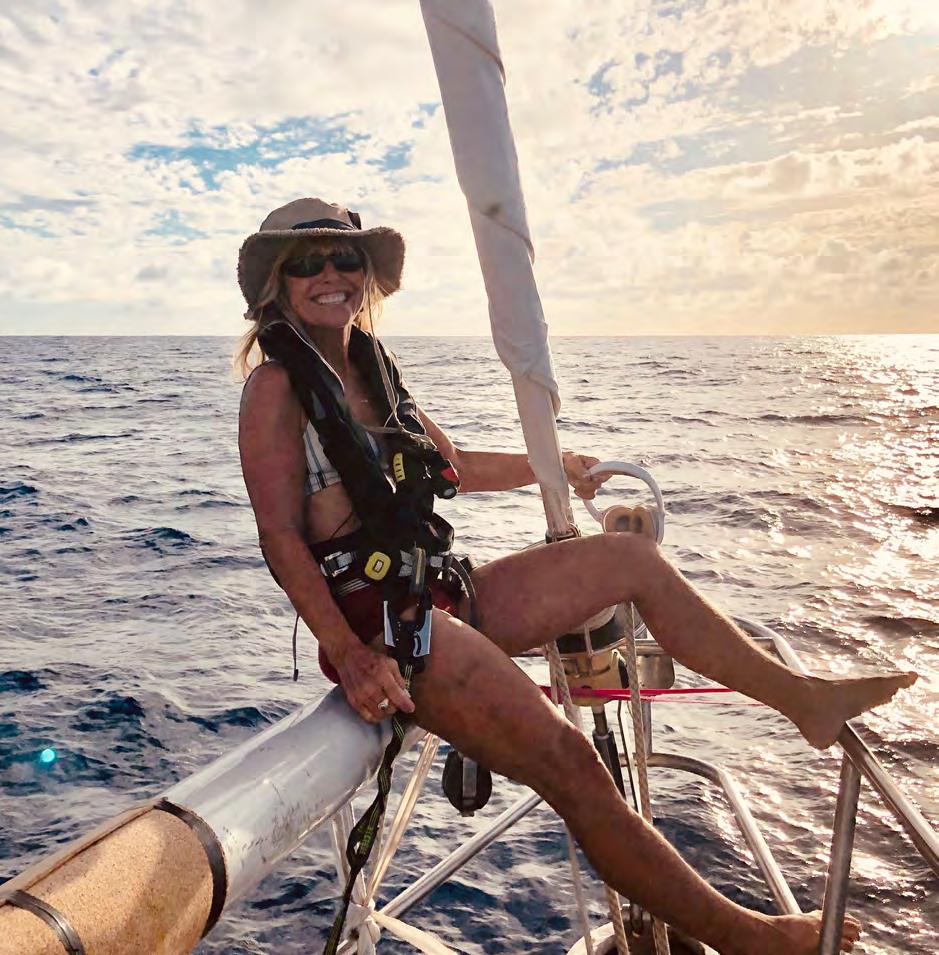
After completing her PhD in 2005, Eriksen was offered a postdoctoral position at a National Oceanic and Atmospheric Administration (NOAA) fisheries lab in Santa Cruz, and she’s called Santa Cruz home ever since, aside from two years as a professor at the University of the South Pacific in Fiji. She’s worked as the Director of Marine Programming for the California Marine Sanctuary Foundation since 2010, coordinating with thousands of partners across the state to protect California’s breathtaking and precious marine legacy. “We work hard to get to know every bait and tackle shop, every West Marine, every dive shop throughout the state,” she explains with a satisfied smile. The team at the CMSF works with the shops to disseminate information about how their users can help protect the oceans. “We don’t preach to people, we put information where they already are, we communicate through conduits they are already plugged into.”
And her dedication seems to be paying off. “California’s newest parks are underwater,” Eriksen explains. “We should be rocking proud of what we’ve accomplished in this state. Our marine protected areas represent a global model for successful protection.”
Despite rewarding work, a supportive community and a tricked out Sprinter camping van, 2019 served up major challenges. Her mother was in and out of the hospital, her aunt had Alzheimer’s and she watched her father get
cancer and waste away in six weeks. “My life literally fell apart,” Eriksen explains. “I had to admit, to myself and others, that I needed help. I couldn’t power through the pain with sheer grit.” So she read books, she listened to podcasts on mindfulness and laughed at herself learning yoga. “I had to go back to the strength I learned all those years ago.” And she had to take a break. “I told my boss I needed something to help me find my passion again.”



So she followed the advice of friends and co-workers and applied for a spot on eXXpedition, a female-only cooperative sailing venture that will circumnavigate the globe examining the causes of plastic pollution. Spanning two years and 38,000 nautical miles, eXXpedition brings together 14 women on a 73-foot Bermuda Ketch. The journey is divided into 30 legs. The women on board, who hail from diverse backgrounds all over the world, work in teams to identify creative grassroots ways to stem the tide of plastic pollution. After a life changing ocean voyage, they return home, ready to educate and inspire their local communities.
With her sailing and science background, Eriksen was a natural fit. She joined the boat for one of the longest legs of the journey, from the Azores to Antigua, over 2,200 nautical miles across the Atlantic Ocean. The crew, who would be in each

other’s pockets for the next five weeks, met on October 21. There was an author, a photographer, a women’s advocate, a government bureaucrat, a teacher, a scientist, a skipper, the first mate, a representative from the plastic industry, and Eriksen, the marine biologist. They met as strangers and parted as best friends.
“We shared 17 sunsets and sunrises, ate 55 packets of biscuits, and conducted 300 scientific samples.” Eriksen says with a laugh. “We danced, we cried, we laughed, we cranked winches, we got sick. We did all kinds of safety drills. In every port we went ashore to do outreach in schools, in malls, in yacht clubs and ministries. Nobody ever yelled on the whole trip,” Eriksen reflects. “It was interesting to see that an all female crew cooperated instead of competing. You’d hear laughter, or these hushed amazed silences. This was by far the best crew I’ve ever sailed with.”
“The ocean was gorgeous every day, it looked amazing,” explains Eriksen. “But our surveys revealed a plastic soup. The water was filled with micro particles.” They found a plastic spoon 1,200 miles from land. “We were seven times more likely to encounter plastic than food a marine mammal could eat. When baby fish mistake plastic for food, they eat it and die. Then there are fewer big fish. They are
OPPOSITE PAGE: ERIKSEN ON THE BOW OF EXXPEDITION SOMEWHERE SOUTH OF LATITUDE 25 DEGREES. THIS PAGE, CLOCKWISE FROM TOP LEFT: SEASICK IN THE COCKPIT WITH HER GRANDFATHER IN THE KATTEGAT OF SCANDINAVIA AT AGE 5; ON THE BOW OF ROB ROY WITH HER SON THATCHER KAI (AGE 4) IN THE VIRGIN ISLANDS; SAILING ON THE INDIAN RIVER IN FLORIDA WITH HER DAD AND HER DOG, SPORT.

eating plastic, we are eating plastic, we all have plastic in our systems!”

Plastic is designed to last forever, but we use it to make products that are designed to last for a couple of minutes. The top three culprits are packaging, transportation and construction. Because plastic is in almost everything we use, tackling the issue of plastic pollution requires a multifaceted approach. There’s not a single solution, but hundreds of solutions that boil down to decisions we make every day. Changing our decisions when shopping for cars, furniture or building supplies makes a difference. Talking with vendors and restaurants makes a difference. Fighting for policy change makes a difference. Progress is measurable. In Eriksen’s hometown of Santa Cruz, just over half of all plastic goes to the landfill, but 30% remains in use, 6-7% is recycled and 8% is incinerated.
Still, worldwide, an estimated 11 million tons of plastic trash are dumped in the world’s oceans every year. Plastic is the single biggest contributor to ocean pollution. “But plastic is not the enemy, insists Eriksen. “We designed it. Society demands it. We all use it.” Which means we need to take responsibility for it. After five


weeks with eXXpedition, Eriksen returned larger than life, more on fire than ever about empowering women and protecting our oceans. She has some straightforward tips for how you can protect our oceans from the plastic menace.





For starters, avoid plastic wherever possible. Use glass or bamboo instead. Buy from companies that don’t use plastics and frequent Zero Waste stores; make good consumer choices. Take a few moments when shopping to ask stores about their plastic use and offer some simple alternatives, to show businesses that consumers care about plastic pollution. Finally, work with local non-profits on ocean conservation and engage with local governments to ban polystyrene, single use plastic bags and bottles.
Despite enduring more than many of us can imagine, Eriksen feels extremely blessed. “Right now, some woman, somewhere, is enduring something more excruciating and horrific than anything I’ve been through,” she explains. “Maybe they survive, maybe they don’t. Maybe they have lifelong disfiguration, which I don’t. I’m lucky, honestly, very very lucky. Lucky to live in a first world country and have access to tools that helped me find my passion, lucky to devote my life towards making the planet a better place.”
After a lifetime at sea, Eriksen has settled into her happy place. She continues to protect marine treasures, while enjoying them and finding a healthy live-work balance. And though more challenges may loom in her life, past experience suggests she will be able to transform them into growth as well. “I’m not always optimistic,” explains
someone else.”


After a lifetime at sea, Eriksen has settled into her happy place. She continues to protect marine treasures, while enjoying them and finding a healthy live-work balance.
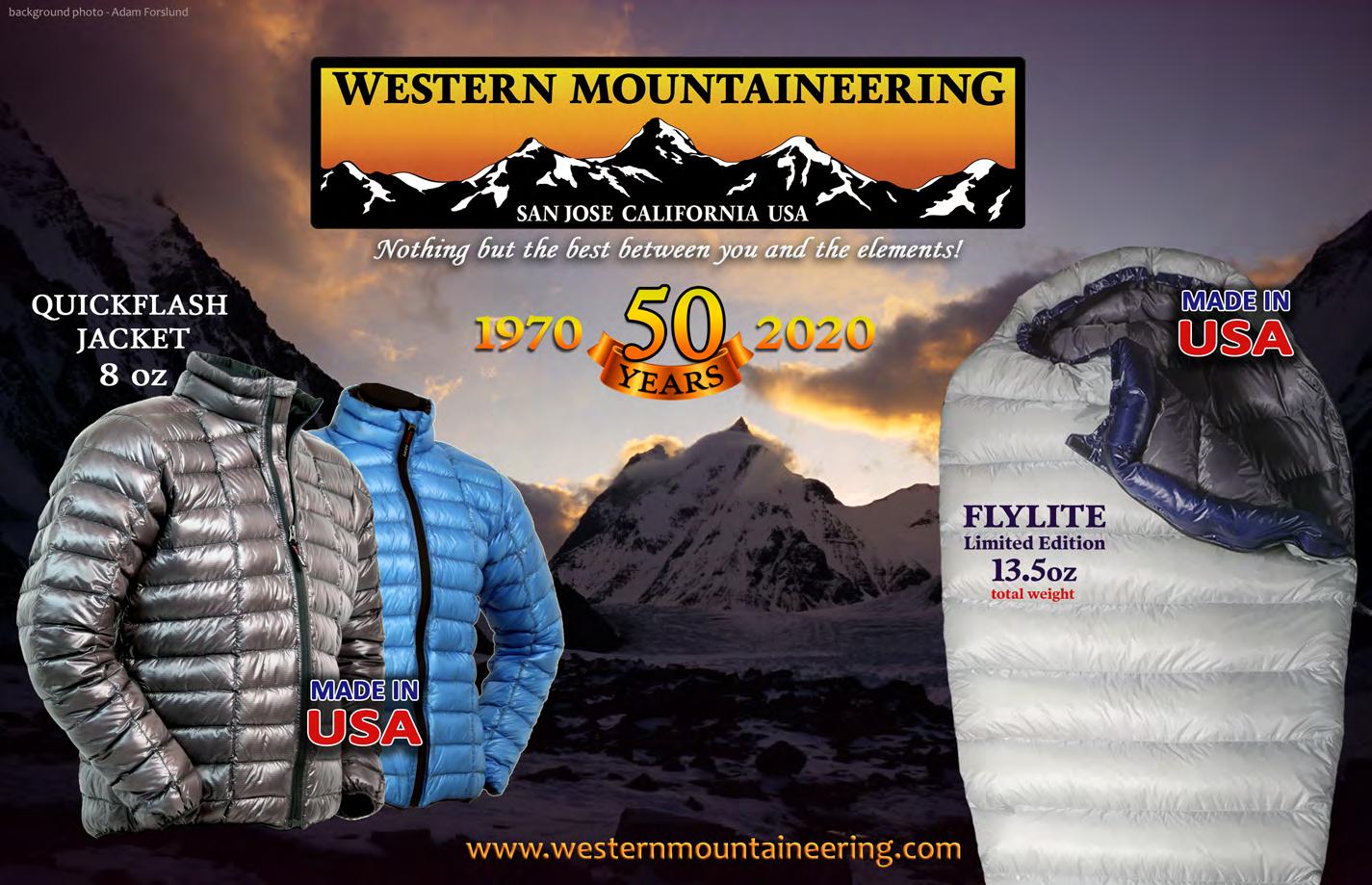

Raging wind shook our tent so fiercely that it felt like a high-elevation earthquake. Four of us camped in two tents at Helen Lake, about halfway up Mount Shasta. But the screaming
of us to cram into the other. Sleep was impossible.
In its early hours, my first climb on Mount Shasta bore a striking resemblance to my family’s previous effort 25 years earlier. On that occasion, my dad and uncle tried to take my older brother and cousin (ages 10 and 12) up the same route, Avalanche Gulch. But a fierce storm struck them in the night too. Dad’s tent broke in the wind and he and my brother had to huddle in my uncle’s shelter. Then the gusts swept the broken tent away, never to be seen again. The four suffered through a wet, sleepless and terrifying night. “I had my first serious conversation with God,” recalled cousin Peter. Their party made a strategic descent the next morning.
A quarter century later, we saw many others going down too. But despite wind that felt strong enough to blow us off the mountain, we made a dubious decision to go up. Freezing cold and our poorlychosen cotton clothes made for a bonechilling combination. Only youthful vigor, stubborn determination and a healthy dose of beginners’ luck allowed us to muscle our way to the summit.
We stood atop the mountain for mere minutes before the icy wind chased us back down. After descending, we discovered the intense sun had badly burned our faces; failing to cover up had been another rookie mistake. Still, pulling off such a significant climb on our first try felt great, giving us an appetite for mountaineering that continues unabated.
Mount Shasta, a 14,179-foot dormant volcano that dominates the North State landscape, has inspired countless other admirers since well before the founding of the United States. Local Native Americans believe the mountain is the center of the universe and inhabited by the Great Spirit. Others say that advanced beings called Lemurians inhabit a city called Telos hidden within Shasta. UFOs and Bigfoot frequent the mountain, some claim.
One could also say that Mount Shasta’s supernatural power is its magnetic pull
broke
Years after Ted and Tom had both passed away, I discovered photos from their previous Mount Shasta ascent, a 1969 climb on the mountain’s north face. Despite this route’s greater difficulty, the two appear on the summit smiling on a beautiful day.
on climbers. Since Elias Pearce and eight companions made the first recorded ascent in 1854, hundreds of thousands have followed in their footsteps, or at least tried. In recent times, some 10,000 attempt the climb per year, with between a third and half succeeding, rangers estimate.
“Shasta was my introduction to mountaineering years ago, and I could see myself climbing it every year,” said my cousin Andy.
About ten years after my first Shasta adventure, Andy and I climbed the massive and magnificent mountain together. The popular Avalanche Gulch route, which covers ten miles round trip and gains about 7,200 feet, tested our mettle. But calmer skies (and a little more wisdom, I hope) allowed us to summit more easily than I had before, and to enjoy the victory more. “Standing on the summit was sweet, with a view for miles all around above the clouds,” Andy recalled.
That outing was the first of many for Andy and me including dozens of other California climbs and summits like Mount Lyell, Matterhorn Peak and Mount Whitney. In hindsight, it seems a little crazy that we started with the hardest one, but then again a little crazy runs in the family.
My dad Tom and Uncle Ted introduced my cousins, brothers and me to pursuits including climbing, backpacking and skiing. Though we’ve laughed about the 1979 Shasta debacle for decades, many positive experiences and a few characterbuilding miscues instilled in us a lifelong affinity for outdoor adventure.

Years after Ted and Tom had both passed away, I discovered photos from their previous Mount Shasta ascent, a 1969 climb on the mountain’s north face. Despite this route’s greater difficulty, the two appear on the summit smiling on a beautiful day.
In our family, that’s enough inspiration to launch a 50th anniversary climb by the sons and nephews. Peter, Andy, my younger brother Dan and I chose a warm June weekend with a favorable forecast. Peter, the only returning member of the 1979 team who remembers that stormy night well, still rented a four-season tent to be on the safe side.
“Shasta has been a life-long inspiration, instructor, motivator, and adversary. My first trip was an eye-opener to challenges, beauty, and danger of mountain climbing, and the unpredictability of high altitude weather,” Peter said. “I was enlightened on that first trip on the importance of quality, well-engineered equipment, and need for serious physical and mental preparation. That one experience changed how I prepare for not just mountaineering, but backpacking in general.”
A long and bumpy dirt road delivered us to Northgate Trailhead, where the 12mile, 7,200-foot trek began. After a half day of hiking and climbing, we made camp at about 9,500 feet.
Rising the next day at 4 a.m. (a moderate hour, by Shasta standards), we strapped on our crampons and started up HotlumBolam Ridge. Like Avalanche Gulch, the route climbed steadily and steeply at times, requiring strength and endurance, but no ropes, protective gear or difficult
THIS PAGE, TOP TO BOTTOM: DAN, PETER, MATT AND ANDY CLIMBED THE NORTH FACE OF THE MOUNTAIN IN 2019, IN HONOR OF THEIR DADS AND UNCLES WHO DID SO 50 YEARS BEFORE (JOHANSON FAMILY PHOTOS); BROTHERS TOM AND TED JOHANSON MADE MULTIPLE CLIMBS ON MOUNT SHASTA, INSPIRING THEIR SONS AND NEPHEWS TO FOLLOW IN THEIR FOOTSTEPS (JOHANSON FAMILY PHOTO). OPPOSITE PAGE, CLOCKWISE FROM TOP: AFTER A HARD DAY OF CLIMBING, ANDY PADLO TAKES A BREAK AT BASE CAMP (DAN JOHANSON); MOUNT SHASTA ATTRACTS AND CHALLENGES THOUSANDS OF CLIMBERS EVERY YEAR (MATT JOHANSON); DAN JOHANSON CELEBRATES HIS FIRST VISIT TO MOUNT SHASTA’S SUMMIT (MATT JOHANSON).


route finding. It’s not tricky, just hard, and you have to keep climbing no matter how tired you are.
“I set mini goals for myself,” Peter recalled. “Take 50 steps, recover breathing for 30 seconds (was it longer?), repeat, over and over. On certain steeper stretches, it was only 25 steps, recover, repeat.”
Hours passed, the sun rose, and the air got thinner as we got wearier. But enthusiasm and adrenaline increased as
our goal got closer. When we turned a last corner and the summit block came into view, cautious optimism gave way to euphoria. The four of us regrouped to summit together, with Dad and Uncle Ted along in spirit. Distant snow-capped peaks, green valleys and scattered clouds filled an especially grand and rewarding view.
“It was special to me that when the summit was in sight, we waited until all of us had caught up so that we could finish this climb together. There’s a unique feeling of facing adversity together that makes the experience all the more special,” Dan shared.

On the descent, Andy put on his skis he had hauled all the way from the trailhead, and relished his hard-earned turns all the way back to camp. “That was something I’ve dreamed of doing for a while, and I’m looking forward to doing it again!” said Andy, who’s already planning a return trip to celebrate his 60th birthday.
Peter, Dan and I delighted in our descent by glissading, which is like sledding without a sled. Climbers slide down steep slopes on their backsides, using ice axes to steer and brake. Elevation that took hours to gain flies by in minutes.
Celebratory meals in camp that night and in town the next day capped an outstanding adventure and my favorite climb of hundreds I’ve experienced. To me, physical challenge, natural beauty, and camaraderie with family and friends all contribute to the appeal of Mount Shasta. I’ve never spotted a Lemurian, UFO or Bigfoot, nor subscribed to supernatural beliefs surrounding the mountain.
But a curious encounter after our climb made me wonder. In town, a woman I’d

never met greeted me as if she knew me. Her hippyish dress, hair and bare feet all expressed a Woodstock vibe. I told her we’d just climbed the mountain. “I have something for you,” she then said, handing me a polished stone, a crystal and a small bell.
Why did she feel a connection? What’s the significance of the items? Can I throw them away without risking the Great Spirit’s wrath? I can’t fathom the answer to any of these questions, so I asked some folks who are versed in the mountain’s spirituality. Their answers were as varied as they were thought provoking.
“That woman must have felt a connection to you and was guided to offer you the gifts,” theorized Andrew Oser, owner of Mount Shasta Retreat. “The crystal is to help you connect with your own inner guidance. The stone is to remind you of Mount Shasta and to help you tune in to the pure energy of the mountain wherever in the world you might be. The bell is for you to ring to call yourself back to the present when you notice you’re getting lost in thoughts about past and future.”
According to Paul Isaac of Mount Shasta Spiritual Tours, “the crystal holds information and the light you need to bring you back to the mountain, this time connecting to the heart of Mount Shasta. You have been invited. It’s an honor, and a beautiful mission,” he revealed.

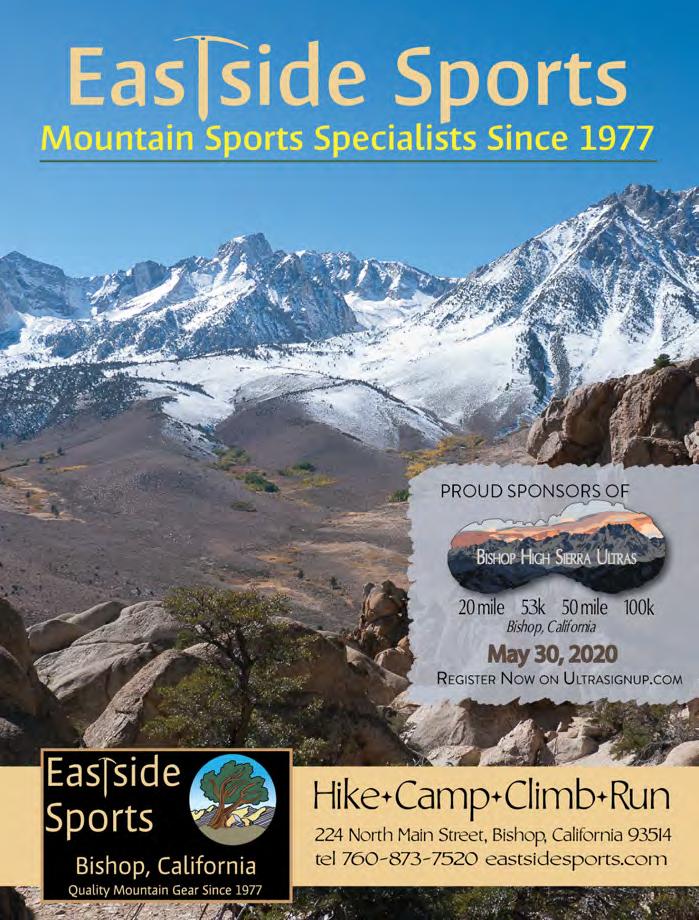
“Ask your intuitive self what all this means to you,” suggested Ashalyn from Shasta Vortex Adventures.
My intuitive self still draws a blank concerning the stone, crystal and bell. But like so many others, I’ve come to see Mount Shasta as a magical place. How else could our clueless party have summited on our first try 25 years ago?
I’m glad we went up instead of down on that windy day.

Let me start by saying I’m probably going to buy one when I turn 50, which is a lot sooner than I’d like to admit — forever 44 is my jam.
Okay, with that said, here’s what I’m thinking.
I’m not a follower, I don’t do fads, I’m old school — pain does equal gain. My husband is even worse, one of the hard gristled tribe, reluctant, even suspicious, of technology. Bikes to him have always meant freedom. It’s as if technology is chewing away at what he holds sacred, so he’s not a fan. He voices to me what most will not say, his fear that the back country and trails will be blown out, filled with people taking selfies and posting to Instagram. I share the same fear, the group mentality morphing from the old goat, to more of a soft cow. Yes, I’m talking about eBikes. Not in the sense of urban commuting, which we can agree is fine and
good, in fact excellent for our society. It has changed my sister’s world and body as her daily commute to work now has two wheels and a small battery. It’s the eBikes on the mountain, on the single-track dirt, the eMTBs.
On a recent mountain bike shuttle, I decided to casually ask the 15 riders (all men except for me; average age of 40) this question as we drove along: “So, what do you all think about eBikes?” The muttered phrase “it’s cheating” was heard throughout the van, followed by an almost unanimous “hell no.” My husband gently nudged me with his elbow, adding an “I told you so” look, content that his view is confirmed. He immediately exclaimed “I hate ‘em,” opening the door to visceral emotions, the older guys having the most hardened views. It was a very strong “hell no,” with the exception of one brave rider, who said he was “thinking about it,” since he’s been so busy with work and the kids, he’s “gained some weight and now has a hard time keeping up with his riding buddies.” These buddies then said, “not until you’re 50 and even then, we’ll still give you shit.”
“Why is this?” I ask. It’s counter opposite to the conversation I had earlier that week, back in Santa Cruz over a delicious brunch after my husband and I finished a long grinder ride, which we call “an epic.” Yes, back to our belief, a hard ride does equal reward, hence the Eggs Benedict and Bloody Marys. We noticed a couple ride up; she had a sick new S-Works Turbo eMTB. It looked awesome, glowing a deep purple in the sun, its battery motor barely detectable. I got a chill up my spine, I wanted it. I knew right then and there; I was looking at the future. The couple was young and fit, fresh off a ride on the mountain. I asked her how she likes it. She replied, “it’s just fun” with a bright-eyed smile. Fun, hmm is it, should it be “just fun”?
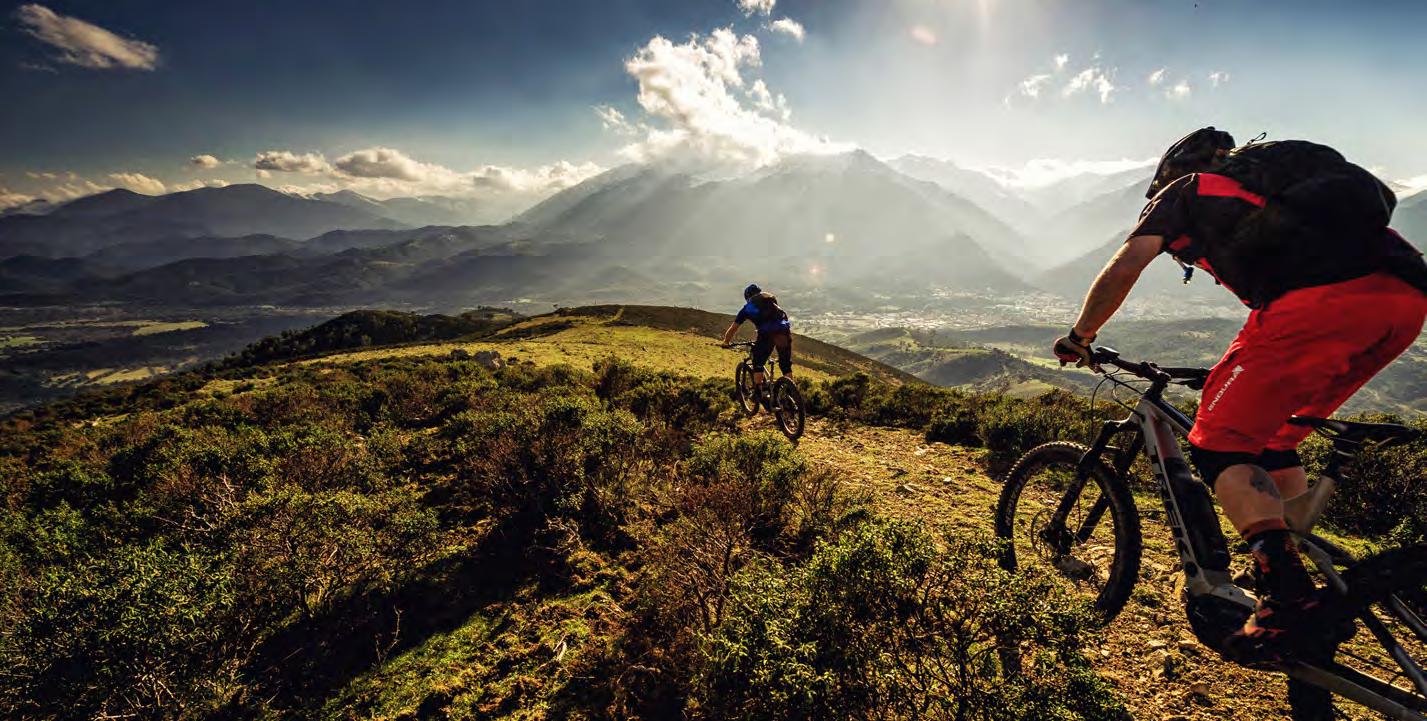
This brings me back to the why. Why as a member of an older die-hard group are we so against this new “fun” technology? I believe, at the core, because mountain biking has been regarded as a discipline. A well-earned sacred discipline. Which with all disciplines, takes time, years of hard work, sweat and tears. I know this, I preach this, I hold this true with every fiber as I learned to ride in Santa Cruz almost 20 years ago and have the scars to prove it. Usually the lone woman amongst the boys, I tend to seek out “disciplines” where few women would go. Surfing was my first, now a 25-plus year love affair filled with heartache, pain, supreme moments of joy and selfadmiration.
These disciplines give me purpose, a sense of belonging, a dedication to a group of like-minded peers. I know when I see another sweaty rider, breathing deep at the top of a long climb, taking a moment to hydrate and contemplate the upcoming descent. We can share a look, a nod of an unspoken connection, affirmation that we have both done the work to get the reward. We are of the same tribe. A few days later, as I clicked down into my last granny gear, I was silently hoping I had just one more. The climb I knew was long and steep, my legs nearly spent, heart pounding out of my chest. Her mocking words came to me “it’s just fun”. My fear of a new tribe, one of which we may not share the nod of affirmation, one of which I may myself soon subscribe. How will I feel after an assisted climb to the top? Will I feel proud, or will there be a little selfloathing? As I said earlier, some things are sacred.
1978 is considered the first year the mountain bike was introduced, founded right here in Northern California. That’s just 41 years ago, a blink in the existence of mountain bike riding. We have gone from 50-pound
I know when I see another sweaty rider, breathing deep at the top of a long climb, taking a moment to hydrate and contemplate the upcoming descent. We can share a look, a nod of an unspoken connection, affirmation that we have both done the work to get the reward. We are of the same tribe.

CLASS 1 Is a low-speed pedal-assist electric bike. The motor requires pedaling to power the bike and it ceases to provide assistance when the speed reaches 20 mph.
CLASS 2 Is a low-speed throttle-assist electric bike. The motor is powered by a throttle and it ceases to provide assistance when the speed reaches 20 mph. Throttleassist eMTBS are not common.
CLASS 3 Like Class 1, Class 3 is a pedal-assist electric bike, but with a higher top speed. The motor requires pedaling to power the bike and it ceases to provide assistance when the speed reaches 28 mph.
hardtail clunkers made of steel to under 10-pound full suspension carbon masterpieces. A reason why the old guard holds things so dear. Those inventors and first pursuants of mountain biking are now in their 60s, most still riding trails on pedal power only. Which explains why we are at such a crossroads in our bike culture. The old guard wants a level playing ground, to be given credit where credit is due. But the new guard knows nothing of this. They only know technology, as they were born into iPhones, the internet and Uber. So, the question of riding an eMTB, isn’t even a question to most. Why not use technology to make things easier and more fun? Would
riding an eMTB be considered a discipline? Maybe that is my real fear, it becomes less work and more fun and I will see a softness developing in my mind and my body. But what if I rode more and for longer on an eMTB? What if I was not a spent wad of flesh after one of those “epic” rides, rather refreshed and motivated to tackle some other project. That’s a good thing, right?
Currently the Specialized S-Works Turbo Levo FSR is top dog in the eMTB world. Yes, that purple beauty I saw laying in the dirt, silently mocking me with the phrase “it’s just fun” costs over $11,000. Considering I spent $5,000 on my last mountain bike, twice the cost is a lot of money for fun.


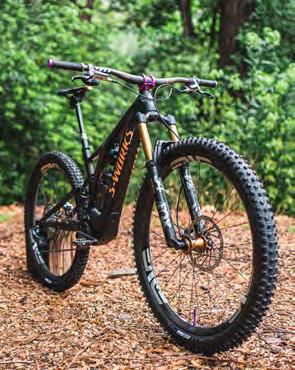

OPPOSITE PAGE: AN ELECTRIC MOUNTAIN BIKE ALLOWS FOR A LONGER RIDE, AND MAKES CLIMBS EASIER WHILE YOU CAN STILL ENJOY A MOTOR-FREE DESCENT (DAN MILNER/ TREK) THIS PAGE: HOUGHTON GOT TO TEST RIDE THE SPECIALIZED TURBO LEVO. MOST MAJOR BIKE BRANDS OFFER EBIKES THESE DAYS. THINGS TO CONSIDER WHEN PURCHASING AN E-MTB ARE CLASS, TYPE OF MOTOR, BATTERY OPTIONS, SUSPENSION, TIRES, BRAKES AND OF COURSE THE GEOMETRY OF THE FRAME. WHAT WORKS FOR ONE RIDER, MIGHT NOT WORK FOR ANOTHER — MODELS VARY DEPENDING ON RIDING GOALS. SEE THE CES AD ON PAGE 28 FOR INFO ON HOW YOU CAN WIN A TURBO LEVO SL COMP CARBON AND SUPPORT TRAILS WHILE YOU’RE AT IT!
Hell, that’s four times what my first car cost! Out comes the old goat ... and I walked six miles in the snow just to get to school. But there must be a reason why eBikes are flying off the shelves.
So, one must evolve, right? My husband says no — never, but he knows my mutiny is brewing. My desire slowly creeping up behind him, like the silent rider on an eMTB. I must ride one to be sure, more research must be done. Not just one ride, but several, alone and within a group. So, I can see their eyes, what is reflected. To be continued …
See next page
We take pride in being one of the top mountain bike shops in the Bay Area for over 20 years and we’ve been rider owned and operated since day one.
Over that time, we’ve followed the progression of mountain biking and have come to fully embrace this new wave of E-mountain bikes. We’re one of the top advocates and retailers in Northern California for Specialized Turbo E-bikes – we’re ‘all in’ on them.

We still love all forms of cycling, but E-bikes have opened up our world to what’s possible on a bike. We’re riding further and faster than ever, and more importantly, having more fun doing it.
Stop by the shop and learn what an E-MTB can do for your riding. See you there or out on the trail!
TrailHeadCyclery.com
(408) 369-9666
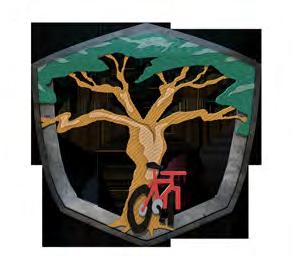
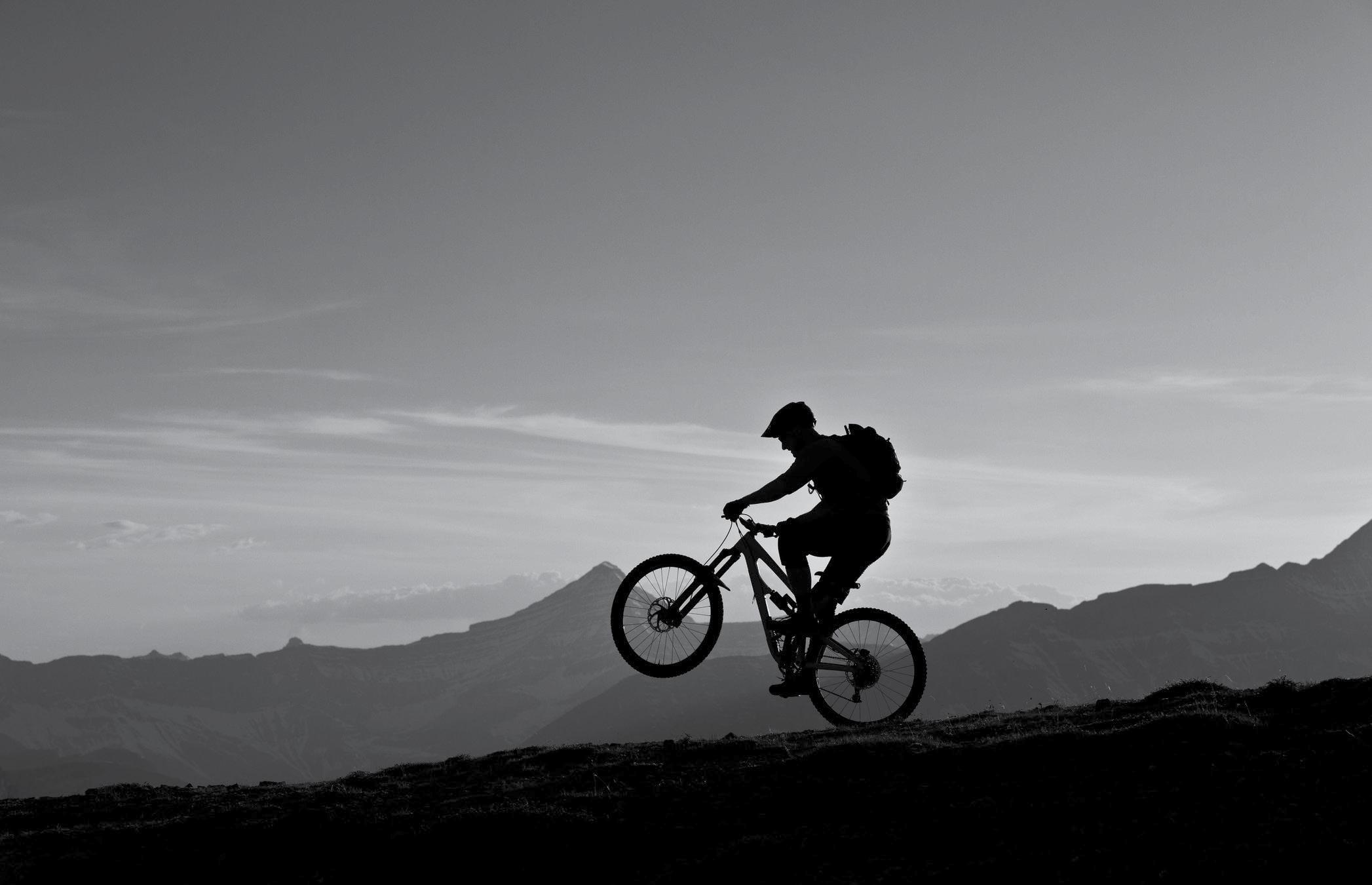




So, one must evolve, right? My husband says no — never, but he knows my mutiny is brewing. My desire slowly creeping up behind him, like the silent rider on an eMTB.
(After several rides on various trails with a sample Turbo Levo provided to me by Specialized and Scotts Valley Cycle Sport.)
“It’s a spaceship!” shouted my 13-yearold, as he took his first pedal stroke and blasted down the driveway. I could hear him laughing as he continued to ride around the property, finally coming to a stop and adding “it’s the Tesla of bikes.” Yep that summarizes it perfectly, the 2020 Specialized Turbo Levo is the Tesla of eMTBs. Call me a traitor, hypocrite, convert, or sellout. I don’t care; this bike is the shit. The old school mentality needs to shift and the saying, “don’t hate what you don’t know” is so true. There is nothing evil or different about this bike. It causes no added impact to any trail and I honestly believe these Class 1 eMTBs should be allowed 100% access to all trails. The only impact would be people enjoying themselves, exercising outdoors and having fun. Isn’t
The power assist is seamless, not jumpy, or awkward. It is me, only better as the Specialized slogan for the Levo says. The



motor design is small and quiet, you can barely see the difference from a traditional “muscle” bike. That is what I am calling non eMTB bikes: analog, misery, or muscle bikes. No matter how often I rode my old bike, every ride was a “suffer-fest”. You know the feeling; cannot breathe, must get off and walk those sections, just demoralizing. And that was my main resistance to the eMTB. If you don’t suffer, then it’s not real riding. Nope, it is still real riding. This bike will not allow beginners to go out there and magically become expert riders. You still need to put in the time, the experiences, the knowledge of technical skills and riding. This bike will only add to your enjoyment, the quality and length of your rides and give those who want to try riding a better first time. Heck, you can still crash and break a leg!
The Turbo Levo’s three power modes allow the rider to adjust to any amount of work and with the Mission Control app you can fully customize the motor assist. You can go low in Eco mode and work up a good sweat or boost it up to Trail mode and climb up those previous impossible sections with confidence. Turbo mode, level 3 is insane! It makes going uphill a blast. Riding the Levo has improved my technical skills and I can ride for longer and stronger than before. From a fitness perspective, this bike will let you burn more fat! You are not maxing out your heart rate, so you’ll be working more in your aerobic capacity, hence more fat burning = awesome.
I can say it is the best performing bike I have ever ridden. The only thing that will hurt, is your ass; from being able to ride for hours, and your face, from smiling. Within the first minute of riding the 2020 Specialized Turbo Levo bike, I knew – this was the future. Try one, I dare you.
ALMOST ALL BIKE SHOPS ARE CARRYING EBIKES THESE DAYS. IN FACT BEFORE THE PANDEMIC BICYCLE BOOM, EBIKES WERE KEEPING A LOT OF BIKE SHOPS ALIVE. CHECK IN WITH YOUR FAVORITE BIKE SHOP TO LEARN WHAT MIGHT BE A GOOD FIT FOR YOUR SKILL LEVEL AND BUDGET. PRICES RANGE FROM $5K – $11K. MOST SHOPS HAVE DEMO PROGRAMS AND IT IS ALWAYS A GOOD IDEA TO TRY BEFORE YOU BUY. THERE IS A PRETTY GOOD CHANCE YOU’LL GET HOOKED.





THE EARNING A long weekend in the Eastern Sierra, that spectacular stretch of majestic mountains along US 395, was a hodgepodge of activities that can only happen when winter is at bay, but then comes sweeping down the mountains and into the valley from the northwest. On a gloriously warm sunshiny winter afternoon, I rode Lower Rock Creek, a trail that serves up fast, swoopy flow in its first two sections, and then delivers several rounds of technical mountain biking, characterized by chunk, chunk, and more chunk. There ain’t no flow down low on Rock Creek, until you get to Paradise. I left a little skin on the trailside granite.
In Mammoth, I finally found some snow. I strapped on snowshoes and wandered off-trail up on the “other” side of the lodge area, following local beta in the form of days’ old meandering xc-ski and snowshoe tracks through the trees, affording opportunities for views of downhill skiers swooping down the mountain while I stood in solitude and silence amidst a winter wonderland. No trail signs to follow, I looked for animal tracks and listened to bird songs, gentle breezes swaying the treezes. Finally, some gravel grinding out in the Wild Willy’s area, by way of the green church road turnoff, provided a blast of true winter. I needed to use the standing crouch with head
down to move my bike and body through 30+ mph head and cross winds as a front moved in, overnight dropping eight inches of fresh powder, the first measureable snow in 40 days, according to folks at the Tamarack Ski Center. The wind was cold, fierce in its entry on a Sierra morning. Up high, the sky was moody, and the peaks soon were veiled in clouds. Winter ripped through my layers and stung my lungs. A smile worked its way onto my face, a bit of a smirked grin saying, “I’m happy to be here.”
THE BEER Mountain Rambler Brewery in Bishop served up a Rye XPA that needed a little more rye for my liking, lacking a peppery kick. Mammoth Brewing Company has its mainstays, which have never really knocked my socks off, but a seasonal Baltic Porter on draft nearly did. The 2-week freshly opened Distant Brewing in Mammoth had several IPAs and DIPAs pouring in the tasting room, all darn good and satisfying my India Pale Ale needs.
Ho hum?
For this round of Earn Your Beer, it is time to honor a true American beer classic. A craft beer icon. One I have been legally drinking for just under 25 years: Sierra Nevada Pale Ale.

When I see the green label, it seems a new memory comes out of nowhere, yet somewhere, from the nooks and crannies of my brain. Years of cheers lost in the synapses come flooding back by way of sight. Then I crack open a can or a bottle and the always-balanced taste that is a “pale ale,” to me, cements those memories back into the folds of my mind and reminds me that seeking perfection is worth the endeavor to get there.
At camp, at home, at the pub, bar or restaurant, it never disappoints. If there were a Mt. Rushmore, nah scratch that, if there were a Mt. Whitney or The Minarets of USA craft beer, Sierra Nevada Pale Ale would be there, no doubt.


100% recycled T-shirts using Recover brand fabrics are available at events and online.

19 — Mt Shasta Enduro - CES #2 / Mt Shasta / CaliforniaEnduroSeries.com
25 — 1-Day Core Fundamentals / Truckee / MTB Skills Clinic / 9AM - 4PM / ASingleTrackMind.com
25 — Alta Alpina Challenge: Riding the Wild Sierra / Markleeville / COVID-19 Edition / Choose up to eight passes / AltaAlpina.org/challenge
26 — Alta Alpina Breakfast & Recovery Ride / Woodfords / Sunday Breakfast & Easy Family Ride / AltaAlpina.org/challenge
26 — Rocks & Drops-Technical Terrain / South Lake Tahoe / MTB skills / 9AM - 4PM / ASingleTrackMind.com
1 - 2 — 1 or 2-Day Core Fundamentals / Wilder Ranch, Santa Cruz / MTB skills clinic / Wheel lifts & cornering on day two / ASingleTrackMind.com
8 — All Mountain Gravity Clinic / Mount Shasta Ski Park / Two day lift access included / ASingleTrackMind.com
29 — Mammoth Bar Enduro - CES #3 / Auburn / CaliforniaEnduroSeries.com
29 - 30 — 1 or 2-Day Core Fundamentals / Marin / MTB skills clinic / Wheel lifts / ASingleTrackMind.com
6 — Napa 9 / Napa Valley / 125M, 9 peakes, 13K of climbing/ napa9.co
12 — Jackson Forest / Mendo. Cty. / GrasshopperAdventureSeries.com
12 — Bear Growl Gravel Grinder / Taylorsville and Greenville / seven ride options / great views / come early and stay late / MountainCircle.org
12-13 — Bike MS: Waves to Wine / Rohnert Park / WavesToWine.org
13 — America’s Most Beautiful Bike Ride / Tour de Tahoe / Lake Tahoe / BikeTheWest.com
18-20 — Silver State 508 / Reno, NV / the508.net
19 — Gold Rush Growler MTB Race / Folsom / TotalBodyFitness.com
20 — Toro Enduro - CES #4 / Salinas / CaliforniaEnduroSeries.com
27- Oct 3 — OATBRAN (One Awesome Tour Bike Ride Across Nevada) / Lake Tahoe to Baker, NV / Epic cycling journey across Nevada / BikeTheWest.com
1 - 4 — Sea Otter Classic / Monterey / SeaOtterClassic.com
3 — Ashland Mountain Challenge - CES Finale / Ashland OR / CaliforniaEnduroSeries.com
3-10 — Arthritis Foundation’s California Coast Classic Bike Tour / SF to LA / Events.Arthritis.org

4 — Great Trail Race / Truckee /Tahoe City / MTB or run / GreatTrailRace.com
10 — Huffmaster Hopper / Maxwell / GrasshopperAdventureSeries.com
10 — Tri-States Gran Fondo / Mesquite, NV / PlanetUltra.com
11 — TBF MTB 50-Miler / Granite Bay, Folsom SRA / TotalBodyFitness.com
11 — Strawberry Fields Forever / Santa Cruz County / CyclistsForCulturalExchange.org/sff
17 — Solvang Century / Solvang / PlanetUltra.com
17 — Usal Hopper / Mendo. Cty. / GrasshopperAdventureSeries.com
18 — San Diego Triathlon Challenge / San Diego / ChallengedAthletes.org
24 — Lake Sonoma MTB / Sonoma Cty. / GrasshopperAdventureSeries.com
31 — Filthy 50+ / Escondido / QuicknDirtyMTB.com
14-15 — Nevada County Women’s MTB Skills Clinic & Camp / Nevada County / YBONC.org
21 — Death Valley Century / Death Valley National Park / PlanetUltra.com
21-22 — Sagebrush Safari / Campo / QuicknDirtyMTB.com
THE CARSON VALLEY ADVENTURE RIDE SERIES

Based on five epic mixed terrain loops that surround Carson Valley: The Brunswick, The Leviathan, The Slinkard, The Tahoe Ridge, and The Powerline. While events have been postponed to 2021 due to COVID-19, you can come year-round to enjoy miles of training and preview routes. For more info visit CVAdventureRides.org
t
1— Truckee Marathon / Truckee / Plus Half Marathon, 50K, & 10K / TruckeeMarathon.com
9 — Marlette 50K and 10 Miler (50K RRCA Western Region Championship, 10 Miler RRCA NV State Championship) / Lake Tahoe’s East Shore / TahoeTrailRunning.com
15 — Bear Growl Gravel Grinder / Taylorsville and Greenville / Marathon, Half Marathon, and 10K Races / 50 participants each / America’s smallest Boston qualifier marathon / MountainCircle.org
15 — XTERRA Trail Run 5K & 10K (10K RRCA NV State Championship) / Incline Village / TahoeTrailRunning.com
22 — Headlands Hundred / Sausalito / 100mi, 75mi, Triple Marathon, 50mi, Marathon / PacificCoastTrailRuns.com
23 — Good Dog - Dirty Dog 5K/10K / Granite Beach, Folsom SRA / TotalBodyFitness.com
5 — Moonlight Madness / Cottonwood Valley, Las Vegas, NV / Half marathon / 1,650’ vertical climb / DesertDash.com
6 — 9/11 Run to Remember / Sacramento / Sac911Run.com
12 — Race the Rails / Ely, NV / ElyNevada.net/Race-the-Rails/
12 — Emerald Bay Trail Run / Tahoe West Shore / TahoeTrailRunning.com
13 — Delta Harvest Run / Brentwood / OnYourMarkEvents.com
19 — Lederhosen 5K / Olympic Valley / TahoeTrailRunning.com

26 — Fears, Tears, and Beers / Ely, NV / Mountain Bike Enduro/ ElyNevada.net/ Fears-Tears-and-Beers/
3 & 4 — 50K (3) & Skyline to the Sea Marathon, Half Marathon (4) / Saratoga / PacificCoastTrailRuns.com
4 — Great Trail Race / Truckee/ Tahoe City / Mountain bike or run / GreatTrailRace.com




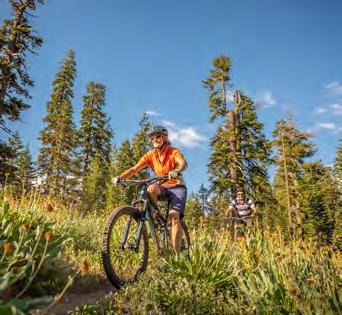


4 — Urban Cow Half Marathon, Relay & 5K Run/Walk / Sacramento / UrbanCowHalf.com
18 — Folsom Blues Breakout 13.1 / Folsom / Plus 5K, Relay, & Kids’ 1K / FolsomBluesHalf.org
31 — Los Muertos 5K / Downtown LA / LosMuertos5K.com
November
7 — Rio Del Lago 100 Mile Endurance Run / Folsom / NorCalUltras.com
7 — Los Muertos 5K/10K / San Diego / LosMuertos5K.com
7 — Bootlegger 25K & 50K / Cottonwood, NV, / DesertDash.com
8 — T9 Mermaid Run San Francisco / Golden Gate Bridge / 5K, 10K, Sirena 10mi, Virtual Run/ MermaidSeries.com

15 — San Francisco Marathon / San Francisco / TheSFMarathon.com
26 — Run to Feed the Hungry / Sacramento / RunToFeedTheHungry.com
27 — Black Mountain Friday Trail Run / Sloan Canyon, Henderson, NV / #optoutside on Black Friday / DesertDash.com
5 — T9 Mermaid Trail Run / Huddart Park, Woodside / 3mi, 6mi, 9mi & Half Marathon / MermaidSeries.com

22 — Alcatraz Sharkfest Swim / San Francisco / SharkFestSwim.com
23 — Lake Tahoe Open Water Swim / Tahoma / TahoeSwimming.com
29 — Lake Tahoe Sharkfest Swim / Incline Village, NV / SharkFestSwim.com
5 — Golden Gate Sharkfest Swim / Sausalito / SharkFestSwim.com
12 — Alcatraz Invitational / San Francisco / 1.27mi open water swim / South-End.org
20 — TikiSwim10 / Oceanside / 1.2mi & 2.4 open water swim / TikiSwim.com
October
4 — Alcatraz Swim with the Centurions / San Francisco / WaterWorldSwim.com
4 — San Diego Sharkfest Swim / San Diego Harbor / SharkFestSwim.com
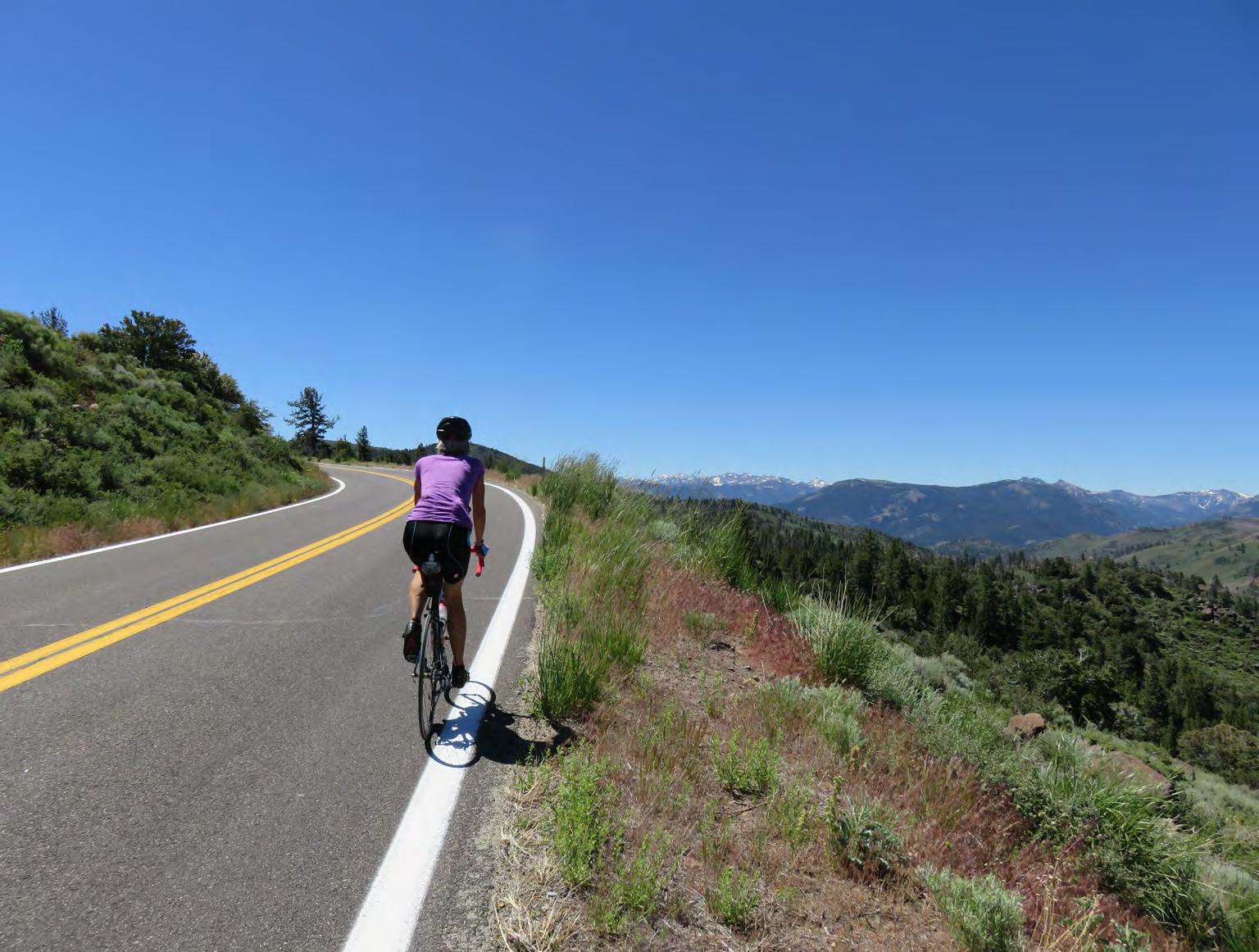





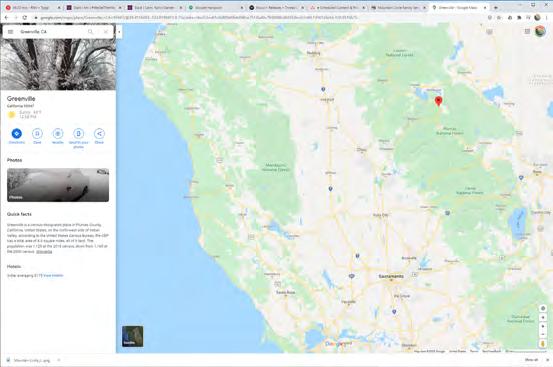












Purpose-built for a water- and sun-based lifestyle, the Astral Loyak AC delivers breathability, flexibility, comfort, and stability. This low-cut, grippy water shoe is ideal for kayaking, SUP, sailing, and fishing. It even makes for an excellent water crossing/ camp shoe on backpacking adventures. It is not, however, recommended for heavy whitewater use.
The sock-like entry, stretchy tongue, minimal weight, level footbed, and wide toebox all combine to make it feel like the shoe is simply an extension of your foot. Plus, the Loyak is so stylish and quick-drying, you’ll want to keep it on for that post-adventure stop for pizza or a brew. Comes in both men- and women-specific styles in a variety of colorways.
MSRP: $110.00 • astraldesigns.com
The Garmin Edge 130 Plus is one of Garmin’s latest and greatest GPS bike computers featuring state of the art navigation, performance insights and safety and tracking features.

Engineered for cyclists, by cyclists, the Edge 130 Plus not only tracks your ride, but monitors stats, provides training guidance and more. Ideal for riding no matter the weather conditions, the Edge 130 Plus features a button design and a 1.8-inch display that’s sharp and easy to read.
Whether you’re an entry-level cyclist, intrepid adventurer, or hard core competitor, you’ll thoroughly appreciate the Edge 130 Plus. We could fill this entire page with all the amazing features this cycling technology boasts, but we have to save room for other gear we’re crazy about. So, hop on Garmin’s website to learn more and prepare to be amazed.
MSRP: $199.99 - $249.99 • garmin.com

The LEKI Micro Vario CorTec TA is the perfect pole for adventures on just about any terrain. Made from aluminum HTS, this pole is lightweight, durable and foldable, packing to a nice compact bundle.
The push-button release mechanism allows for quick, easy assembly and the poles knockdown to just 15.5”.
Edgeless and ultralight




Aergon CorTec grips deliver a truly comfortable fit; the strap is ultra-lightweight and breathable.
Additionally, the trekking basket is compatible with every Flextip, and offers excellent protection against sinking in.
This phenomenal technology comes at an affordable price and includes a travel/stow bag.

MSRP: $139.95/pair • leki.com
The Fi smart dog collar isn’t just smart, it’s durable, stylish, and intuitive to boot. Created from noticeably highgrade materials, this location/activity tracking collar is both chew-proof and waterproof, and can stand up to just about any adventures Fido takes off on. The collar’s technology — which pairs with WiFi, Bluetooth and cell service — not only keeps track of your pup’s whereabouts, but also how many steps and miles he/she travels each day — great for making sure your best friend stays in shape.
There’s a social aspect to the Fi collar as well. Your canine friend can compete against other dogs wearing Fi collars nationwide, and you can connect with other Fi dogs in your area. You can even link up to your pup’s Instagram to share his/her adventures!
The Fi collar’s battery is proven to be remarkably long lasting. Band choices include blue, gray, yellow, and pink in sizes S thru XL. 30-day GPS trial plus one year warranty included.


Ladies, if you’re looking for a lightweight, comfortable, multi-day pack, the Gregory Maven 55 is a dream-cometrue. Weighing just over 3lbs, this durable and spacious pack does not compromise on comfort thanks to features like the FreeFloat breathable suspension, the dynamic flex panels that move with your body, and the 3D foam back panel.
In addition, it comes in two sizes (XS/SM and SM/MD), each with a fully adjustable torso length and hipbelt to create a customizable fit for every body.
But what about capacity and storage details, you ask? No worries, because the Maven’s HD Nylon can handle loads up to 55L and 50lbs.
MSRP: $149.00 • tryfi.com
There’s nothing quite like a nice, cold bevo or sweet, juicy piece of fruit on a long, hot adventure. Enter the new Stashers v3.0 insulated bag which features a removable, food-grade liner that safely carries drinks, fruit, snacks, ice — whatever you need to make your epic outing even more epic.
Wide, durable straps extend fully around the bag and can be snugged up well, offering optimum support and stability on even the bumpiest rides. Fasten the bag to just about any place on your bicycle, kayak, Jeep roll bar, backpack, etc. The set of three bags come in assorted sizes (and colors) which can be used together as a comprehensive storage system for everything you need — and want — to bring along on your adventure.
MSRP: $34.99 - $44.99 • getstashers.com
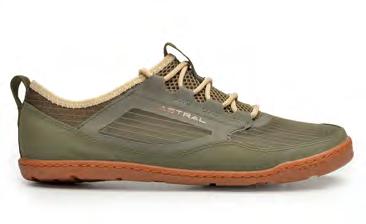
If you are looking for a high top mountain biking shoe that is also designed for hiking and trail building, the Trailcross Mid Pro from Five Ten is your jam. This shoe is a hybrid of an Adidas trail running shoe and an MTB-specific shoe designed for flat pedals.
Designed for longer rides, this shoe features an inner ankle cuff that protects from dirt and rocks entering the top of the shoe and grinding against your foot and heel. Around the cuff and also protecting the ankle are the same D30 plastic armor guards used by motorcycle riders for body armor. This well-placed armor protects against sharp sticks and rocks and other trail hazards, including your own pedals. Stealth rubber with Five Ten’s trademark dot pattern delivers dependable sticky connection to your pedals at all times. While previous Five Ten bike shoes feature designs inspired by skate culture, the Trailcross series features a trail running look. For people who explore new trails and need sticky shoes for flat pedals that are also suitable for hiking and trail maintenance, these are the best MTB shoes on the market hands down.

MSRP: $170.00 • adidasoutdoor.com
Smart features like a side-loading access zipper, a floating top pocket with two zippered sections, dual side stretch mesh pockets, an oversized front stretch mesh pocket, and a zippered bottom sleeping bag compartment, make for easy and accessible organization of your gear. Throw in an internal hydration sleeve and a custom fitted raincover and this pack will check all your boxes!
Available in Rosewood Red or Spectrum Blue.
MSRP: $229.95 • gregorypacks.com


Your water or other hydration fluid will stay cooler longer in the double-wall, insulated 18-ounce flask while your smartphone tucks easily into the seethrough touchscreen pocket. Headphone access at the bottom is another big plus.
But what we love most about this versatile carrier is that it includes Nathan’s award-winning SaferRun Ripcord Siren to deter a would-be attacker. Simply pull to activate a siren that’s as loud as an ambulance. Futhermore, the hand sleeve lets you relax your hand for easy carry; no more gripping a water bottle on your pedestrian adventures!
MSRP: $54.99 • nathansports.com



